1. Comparing EBITDAL to Other Intangible Asset Measures
EBITDAL (Earnings Before Interest, Taxes, Depreciation, Amortization, and Leases) is a measure of a company's financial performance that adds back certain expenses to the net income. The purpose of this measure is to provide a more accurate representation of a company's profitability by excluding non-operating expenses. While EBITDAL is a useful measure, it is not the only measure of intangible assets. In this section, we will compare EBITDAL to other intangible asset measures to determine which is the best option for evaluating a company's financial performance.
1. EBITDA
EBITDA (Earnings Before Interest, Taxes, Depreciation, and Amortization) is a measure of a company's financial performance that adds back certain expenses to the net income. The purpose of this measure is to provide a more accurate representation of a company's profitability by excluding non-operating expenses. EBITDA is a commonly used measure of intangible assets, but it does not include lease expenses. EBITDA may be a good measure for companies that do not have significant lease expenses, but it may not be the best option for companies that do.
2. Adjusted EBITDA
Adjusted EBITDA is a measure of a company's financial performance that adds back certain expenses to the net income. The purpose of this measure is to provide a more accurate representation of a company's profitability by excluding non-operating expenses. Adjusted EBITDA is similar to EBITDA, but it includes adjustments for certain items such as stock-based compensation and restructuring charges. Adjusted EBITDA may be a good measure for companies that have significant non-operating expenses, but it may not be the best option for companies that do not.
3. Free Cash Flow
Free Cash Flow is a measure of a company's ability to generate cash from its operations. The purpose of this measure is to determine how much cash a company has available to pay dividends, buy back stock, or invest in growth opportunities. Free Cash Flow is calculated by subtracting capital expenditures from operating cash flow. Free Cash Flow may be a good measure for companies that have significant capital expenditures, but it may not be the best option for companies that do not.
4. Return on Assets
Return on Assets is a measure of a company's profitability relative to its total assets. The purpose of this measure is to determine how efficiently a company is using its assets to generate profits. Return on Assets is calculated by dividing net income by total assets. Return on Assets may be a good measure for companies that have significant assets, but it may not be the best option for companies that do not.
There is no one-size-fits-all measure of intangible assets. Each measure has its strengths and weaknesses, and the best option depends on the company's specific circumstances. EBITDAL may be a good measure for companies that have significant lease expenses, but it may not be the best option for companies that do not. Companies should carefully evaluate their financial performance using multiple measures to get a more complete picture of their financial health.
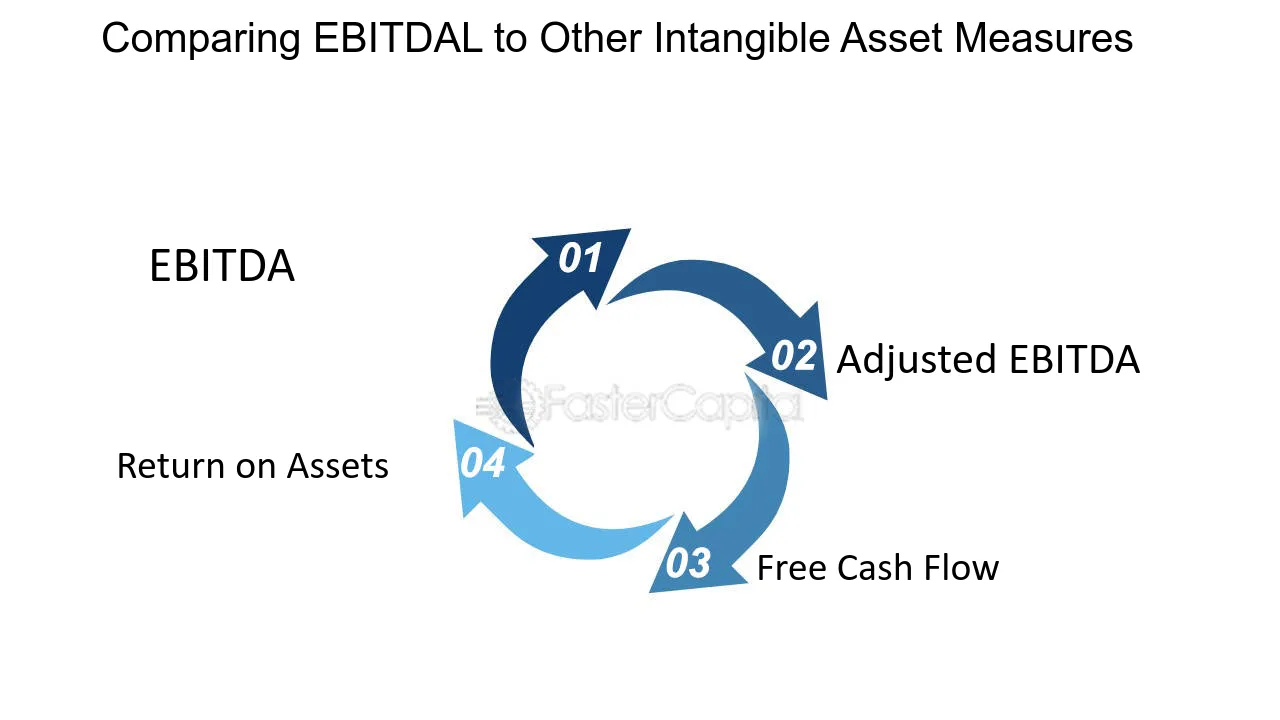
Comparing EBITDAL to Other Intangible Asset Measures - Amortization: Evaluating EBITDAL as a Measure of Intangible Assets
2. Intangible Asset Appraisal Techniques for Business Assets
When it comes to valuing a business, intangible assets play a crucial role. These assets are generally non-physical, but they can be valuable in terms of contributing to a company's overall value. Examples of intangible assets include intellectual property, brand recognition, customer relationships, and proprietary technology. However, putting a value on these assets can be a tricky business. In this section, we will explore some of the most commonly used intangible asset appraisal techniques for business assets.
1. Cost Approach
The cost approach is a method that estimates the value of an intangible asset by calculating the cost of replacing it. This technique is primarily used for assets that are not easily transferable, such as patents or copyrights. The cost approach takes into account the cost of research and development, legal fees, and other expenses associated with creating the asset. However, this approach can be challenging to use for assets that are difficult to replicate.
2. Income Approach
The income approach is a method of valuing an intangible asset based on the income it generates. This technique is commonly used for assets such as trademarks, customer relationships, and proprietary technology. The income approach involves estimating future cash flows generated by the asset and discounting them to the present value. This approach can be challenging to use if the asset's future income is uncertain.
3. Market Approach
The market approach is a method of valuing an intangible asset based on the prices of comparable assets in the market. This technique is commonly used for assets such as trademarks, patents, and copyrights. The market approach involves analyzing the prices of similar assets sold in the past and using that information to estimate the value of the asset. This approach can be challenging to use if there are few comparable assets in the market.
4. Multi-Period Excess Earnings Method
The multi-period excess earnings method is a method that estimates the value of an intangible asset based on the cash flows it generates over a period of years. This technique is commonly used for assets such as customer relationships and proprietary technology. The multi-period excess earnings method involves estimating the expected cash flows generated by the asset over a period of years and discounting them to the present value. This approach can be challenging to use if the asset's future cash flows are uncertain.
5. Relief From Royalty Method
The relief from royalty method is a method of valuing an intangible asset based on the amount of money that would need to be paid to license the asset. This technique is commonly used for assets such as patents and copyrights. The relief from royalty method involves estimating the amount of money that would need to be paid to license the asset and discounting it to the present value. This approach can be challenging to use if there are few comparable assets in the market.
There are several intangible asset appraisal techniques for business assets. Each method has its advantages and disadvantages, and the best approach depends on the type of asset being valued. The income approach is the most commonly used technique, but it can be challenging to use if the asset's future income is uncertain. The market approach is useful for assets with many comparable assets in the market, while the cost approach is suitable for assets that are difficult to replicate. The multi-period excess earnings method and the relief from royalty method are useful for estimating the value of assets with long-term cash flows and licensing potential, respectively. Understanding these techniques can help businesses unlock the value of their intangible assets and make informed decisions about their investments.
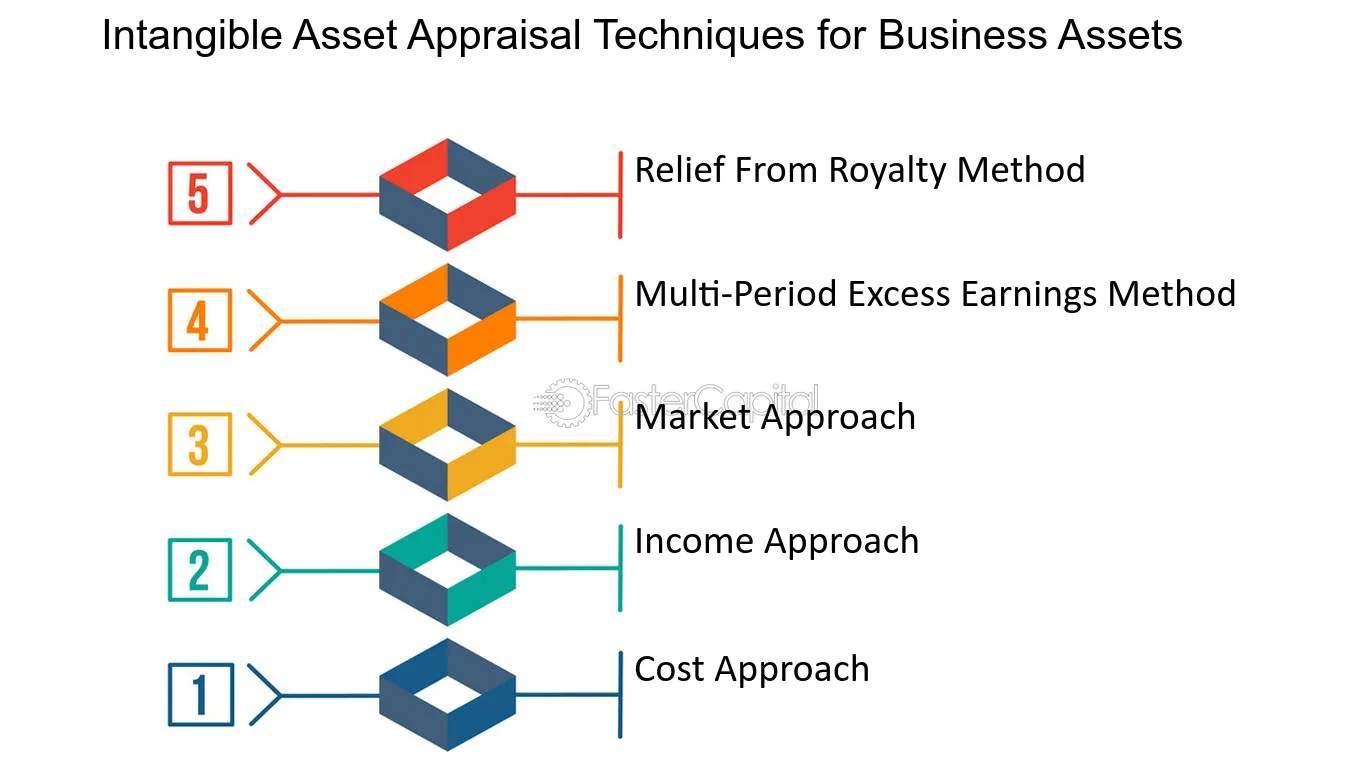
Intangible Asset Appraisal Techniques for Business Assets - Appraisal Capital Techniques: Unlocking Value in Business Assets
3. Intellectual Property as an Intangible Asset
Intellectual property (IP) refers to creations of the mind, such as inventions, literary and artistic works, designs, and symbols. It is protected by various legal mechanisms, including patents, copyrights, trademarks, and trade secrets. Intellectual property is a valuable intangible asset for companies as it grants them exclusive rights over their innovations and creations, allowing them to capitalize on their investment in research and development.
Valuing Intellectual Property:
1. cost approach: The cost approach determines the value of intellectual property based on the cost incurred to create or replace it.
2. Market Approach: The market approach estimates the value of intellectual property by comparing it to similar assets that have been sold in the market.
3. Income Approach: The income approach values intellectual property based on the expected future income it will generate for the company.
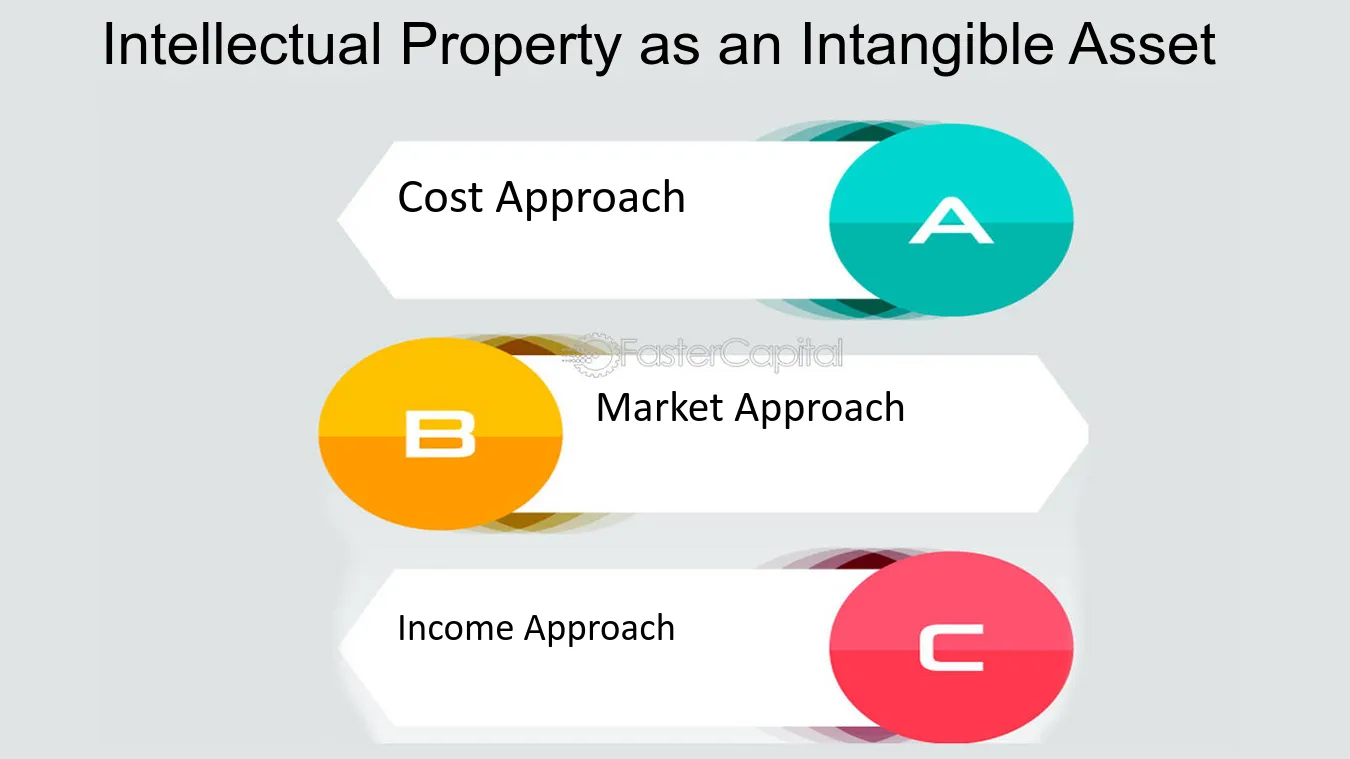
Intellectual Property as an Intangible Asset - Delving into Intangible Assets and their Effect on a Balance Sheet
4. Assessing Intangible Asset Impairment
1. Assessing Intangible Asset Impairment
Intangible assets play a vital role in the success and value of a company. These assets, such as patents, trademarks, and customer relationships, are often the drivers of future cash flows and competitive advantage. However, just like tangible assets, intangible assets can also become impaired, resulting in a decrease in their value. In this section, we will explore the process of assessing intangible asset impairment and the considerations involved.
2. Identifying Indicators of Impairment
The first step in assessing intangible asset impairment is to identify indicators that suggest a potential decrease in value. These indicators can include internal factors such as changes in the legal or regulatory environment, loss of key personnel, or technological advancements that render the asset obsolete. External factors like changes in market conditions, increased competition, or a decline in the industry's growth rate can also signal impairment.
For example, a software development company may have invested significant resources in developing a proprietary technology. However, if a competitor releases a similar technology that gains widespread adoption, it could indicate impairment of the company's intangible asset.
3. Performing a Recoverability Test
Once indicators of impairment are identified, a recoverability test is conducted to determine whether the carrying value of the intangible asset can be recovered through future cash flows. This test compares the asset's carrying value to its estimated undiscounted future cash flows. If the carrying value exceeds the estimated future cash flows, it suggests that the asset is impaired.
For instance, a pharmaceutical company may have acquired a patent for a new drug. However, if the estimated future cash flows from the drug's sales are lower than the carrying value of the patent, it may indicate impairment.
4. Measuring the Impairment Loss
If the recoverability test indicates impairment, the next step is to measure the impairment loss. The impairment loss is calculated as the difference between the carrying value of the intangible asset and its fair value. The fair value can be determined using various methods, such as discounted cash flow analysis, market multiples, or independent appraisals.
For example, a media company may have acquired a brand name that has lost its relevance due to changing consumer preferences. To measure the impairment loss, the company may engage an independent appraiser to assess the fair value of the brand name based on its market recognition and potential future earnings.
5. Disclosing and Reporting Impairment
Once the impairment loss is measured, it must be disclosed and reported in the company's financial statements. The disclosure should provide sufficient information about the impairment, including the nature of the intangible asset, the reasons for impairment, and the amount of the impairment loss.
It is important for companies to adhere to accounting standards and guidelines when assessing and reporting intangible asset impairment. Failure to do so can result in misleading financial statements and potential legal consequences.
Assessing intangible asset impairment requires a systematic approach and careful consideration of various indicators and factors. By identifying potential impairment, performing recoverability tests, measuring impairment losses, and properly disclosing and reporting the impairment, companies can ensure the accuracy and transparency of their financial statements.
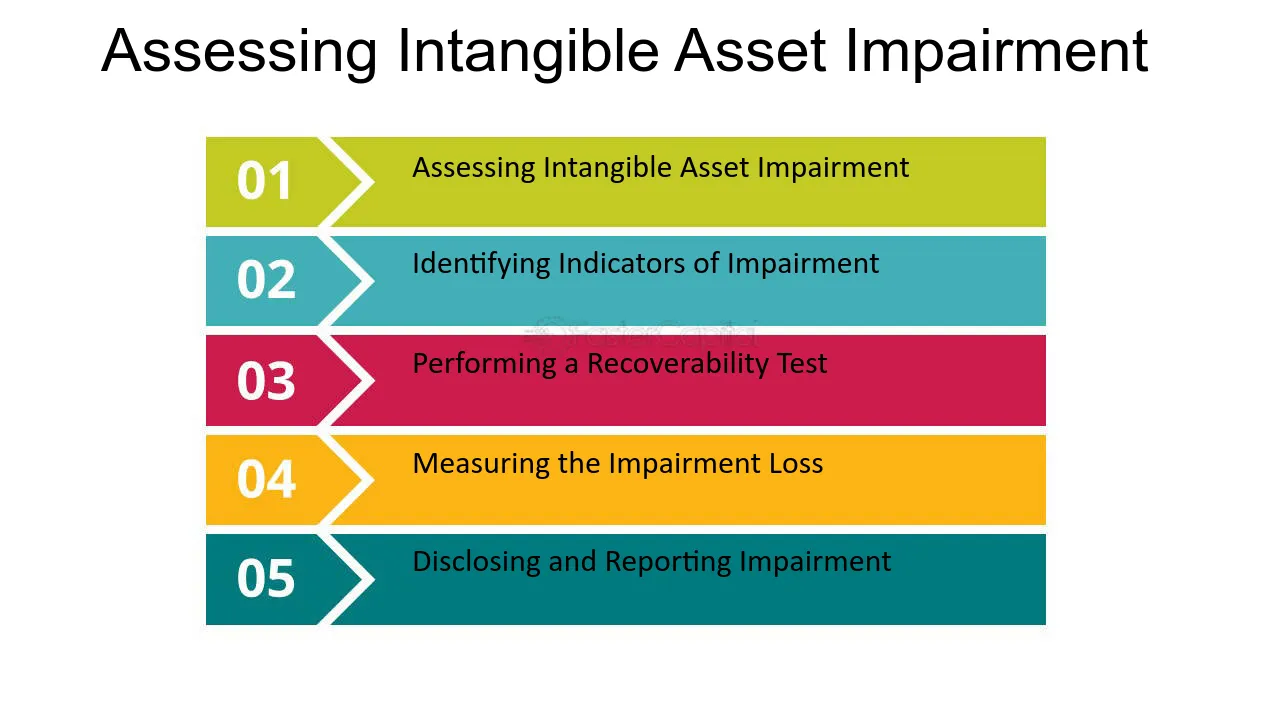
Assessing Intangible Asset Impairment - Examining Acquisition Adjustments: Testing for Asset Impairment
5. An Essential Intangible Asset
Trademarks are an essential intangible asset that can add significant value to a business. A trademark is a unique symbol, design, word, phrase, or a combination of these that distinguishes a company's products or services from those of its competitors. It is a valuable asset for a business as it helps to build brand recognition and customer loyalty. A strong trademark can help a business stand out in a crowded market and create a positive image in the minds of its customers. From a legal perspective, a trademark provides exclusive rights to use the mark in connection with the goods or services it represents, preventing others from using it without permission.
Here are some important insights into why trademarks are an essential intangible asset:
1. Brand Recognition: A strong trademark can help a business stand out in a crowded market and create a positive image in the minds of its customers. It helps to create brand recognition and customer loyalty, which can lead to increased sales and profits. For example, the Apple logo is instantly recognizable and has become synonymous with quality and innovation.
2. Competitive Advantage: A trademark can provide a competitive advantage by preventing others from using a similar mark in connection with similar goods or services. This helps to protect the business from potential infringements and copycats, which can damage the brand and reputation of the company.
3. Asset Value: A trademark is an intangible asset that can add significant value to a business. It can be licensed, sold, or used as collateral for financing. The value of a trademark can increase over time as the brand becomes more established, making it a valuable long-term investment.
4. Legal Protection: A trademark provides legal protection to the owner by giving them exclusive rights to use the mark in connection with the goods or services it represents. This prevents others from using the mark without permission, protecting the brand and reputation of the business.
Trademarks are an essential intangible asset that adds value to a business. They help to create brand recognition, provide a competitive advantage, have asset value, and provide legal protection. A strong trademark can help a business stand out in a crowded market and create a positive image in the minds of its customers, leading to increased sales and profits.
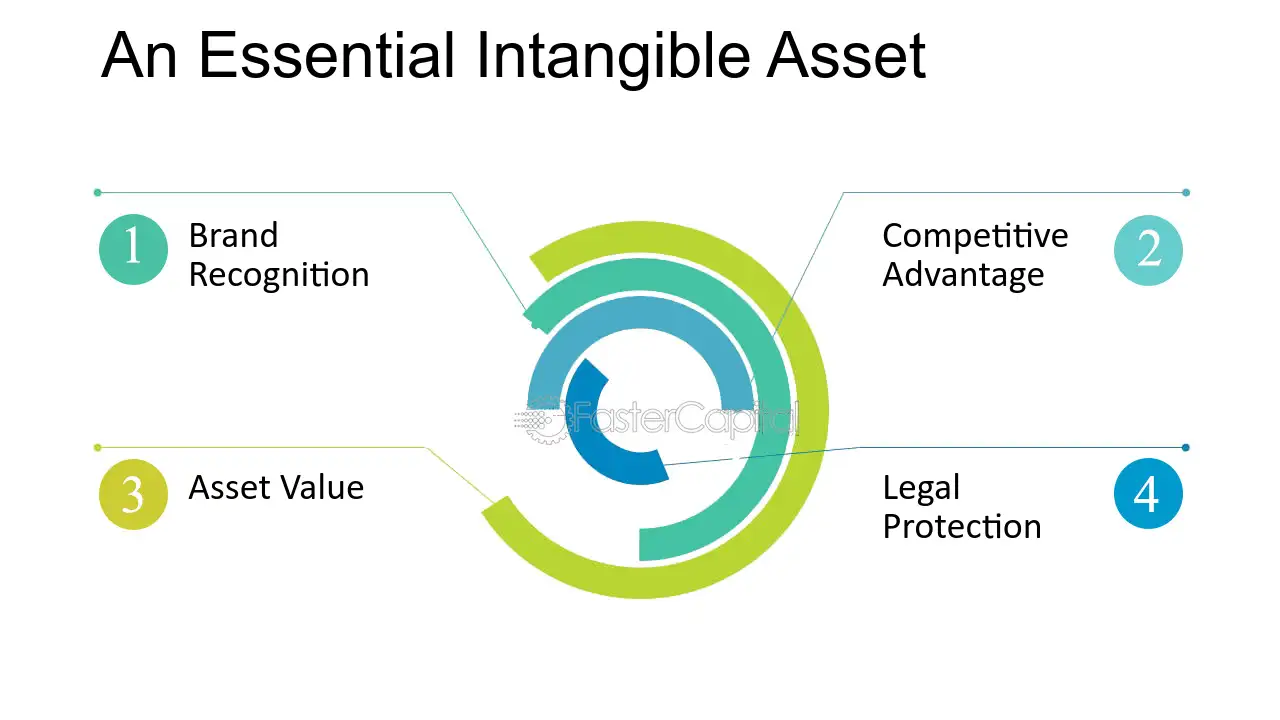
An Essential Intangible Asset - From Trademarks to Profits: Amortizing Intangibles for Business Success
6. A Valuable Intangible Asset
When it comes to building a successful business, it's not just about the physical assets that a company owns. In today's economy, intangible assets can be just as valuable, if not more so, than tangible ones. And one intangible asset that is often overlooked is customer relationships. These relationships are built on trust, loyalty, and satisfaction, and they can be a valuable source of revenue for a business. In fact, studies have shown that it is 6-7 times more expensive to acquire a new customer than it is to retain an existing one. This is why customer relationships should be considered a valuable intangible asset that can be leveraged for long-term success.
Here are some insights on why customer relationships are so valuable:
1. Repeat business: When customers are satisfied with a company's products or services, they are more likely to come back for more. This not only generates repeat business, but it can also lead to positive word-of-mouth marketing. Satisfied customers are more likely to recommend a company to their friends and family, which can lead to even more business down the line.
2. Brand loyalty: Building strong customer relationships can also lead to brand loyalty. customers who are loyal to a brand will continue to choose that brand over its competitors, even if they are offered similar products or services at a lower price. This can be a powerful advantage in a competitive market.
3. reduced marketing costs: When a company has a loyal customer base, it can reduce its marketing costs. Instead of spending money on expensive marketing campaigns to attract new customers, the company can focus on retaining its existing customers through loyalty programs, personalized experiences, and excellent customer service.
4. Increased revenue: Companies with strong customer relationships can also generate more revenue. Satisfied customers are more likely to purchase additional products or services from the company, and they may also be willing to pay more for those products or services. This can lead to increased profits and a stronger bottom line.
Customer relationships are a valuable intangible asset that should not be overlooked by businesses. By building strong relationships with customers, companies can generate repeat business, increase brand loyalty, reduce marketing costs, and increase revenue. Investing in customer relationships can pay off in the long run, and it can be a key factor in a company's long-term success.
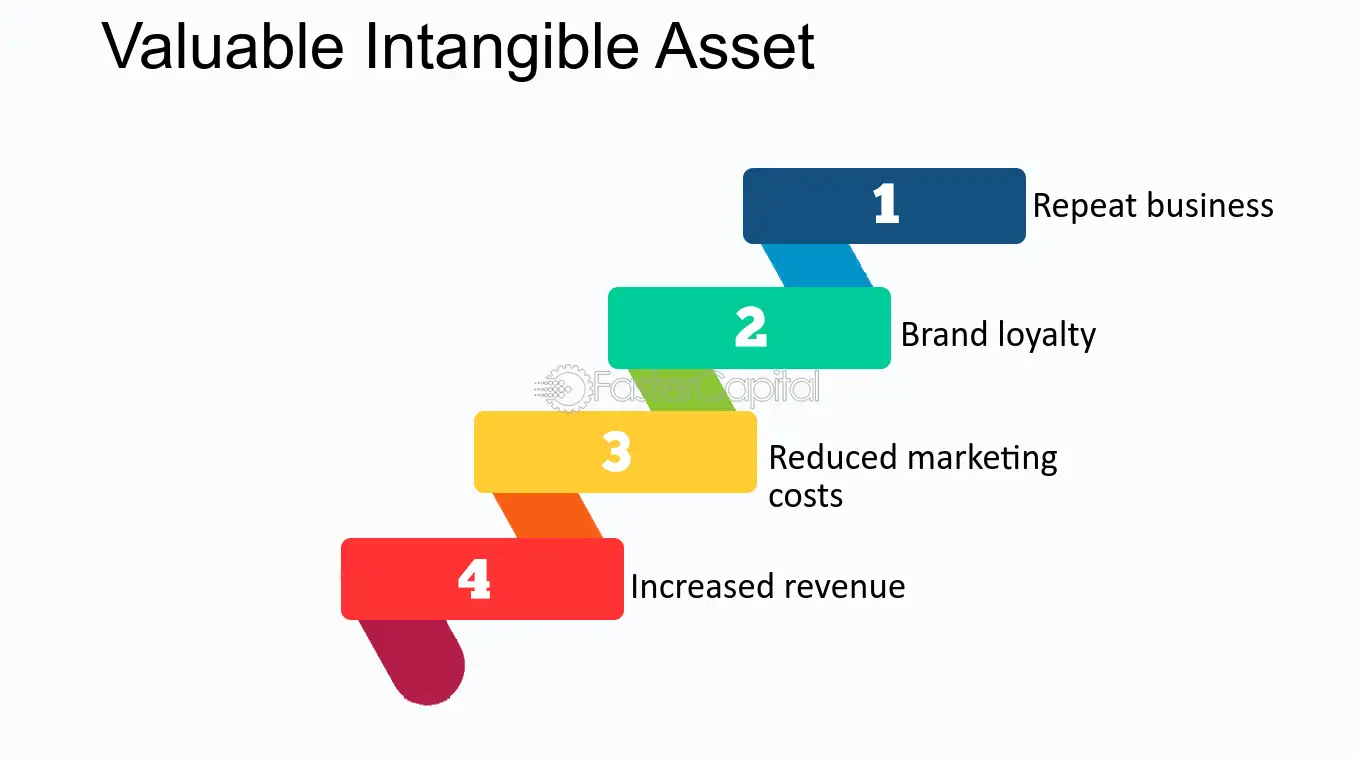
A Valuable Intangible Asset - From Trademarks to Profits: Amortizing Intangibles for Business Success
7. AVRs Impact on Intangible Asset Valuation
Intangible assets refer to non-physical assets that provide value to a company, such as intellectual property, brand recognition, and customer relationships. Assessing the value of these assets is crucial for businesses, especially when it comes to mergers and acquisitions. One important tool used to evaluate intangible assets is the Adjusted Present Value (APV) method, which takes into account the Asset Value Reversion (AVR) of the assets. In this section, we will explore the impact of AVR on intangible asset valuation.
1. Definition of AVR: AVR is the expected rate of growth of the intangible asset's operating income after a certain period of time. This growth rate is used to forecast the future cash flows generated by the asset. The APV method then discounts these cash flows back to their present value to determine the asset's current value. The AVR can be positive, negative, or zero, depending on the asset's expected performance.
2. Factors affecting AVR: The AVR of an intangible asset is influenced by several factors, including the asset's industry, the level of competition, and the asset's age. For example, a new technology patent in a rapidly growing industry may have a high AVR, while a mature brand in a highly competitive market may have a low AVR.
3. Importance of AVR in intangible asset valuation: The AVR plays a crucial role in determining the value of intangible assets, as it affects the future cash flows generated by the asset. A higher AVR will result in a higher asset value, while a lower AVR will result in a lower value. Therefore, it is important to accurately forecast the AVR when valuing intangible assets.
4. Challenges in estimating AVR: Estimating the AVR of an intangible asset can be challenging due to the uncertainty surrounding future cash flows. A variety of methods can be used to estimate the AVR, including regression analysis, expert opinions, and industry benchmarks. However, these methods are not foolproof and can result in inaccurate valuations.
5. Comparison with other valuation methods: The APV method with AVR is not the only method used to value intangible assets. Other methods, such as the discounted cash flow (DCF) method and the market approach, may also be used. However, the APV method with AVR is considered to be more accurate in valuing intangible assets, as it takes into account the asset's unique characteristics and expected future performance.
The AVR is a crucial factor in valuing intangible assets, as it determines the future cash flows generated by the asset. Accurately forecasting the AVR can be challenging, but it is important for businesses to use the most appropriate method to estimate it. The APV method with AVR is considered to be the most accurate method for valuing intangible assets, but it is important to consider other methods as well to ensure a comprehensive valuation.
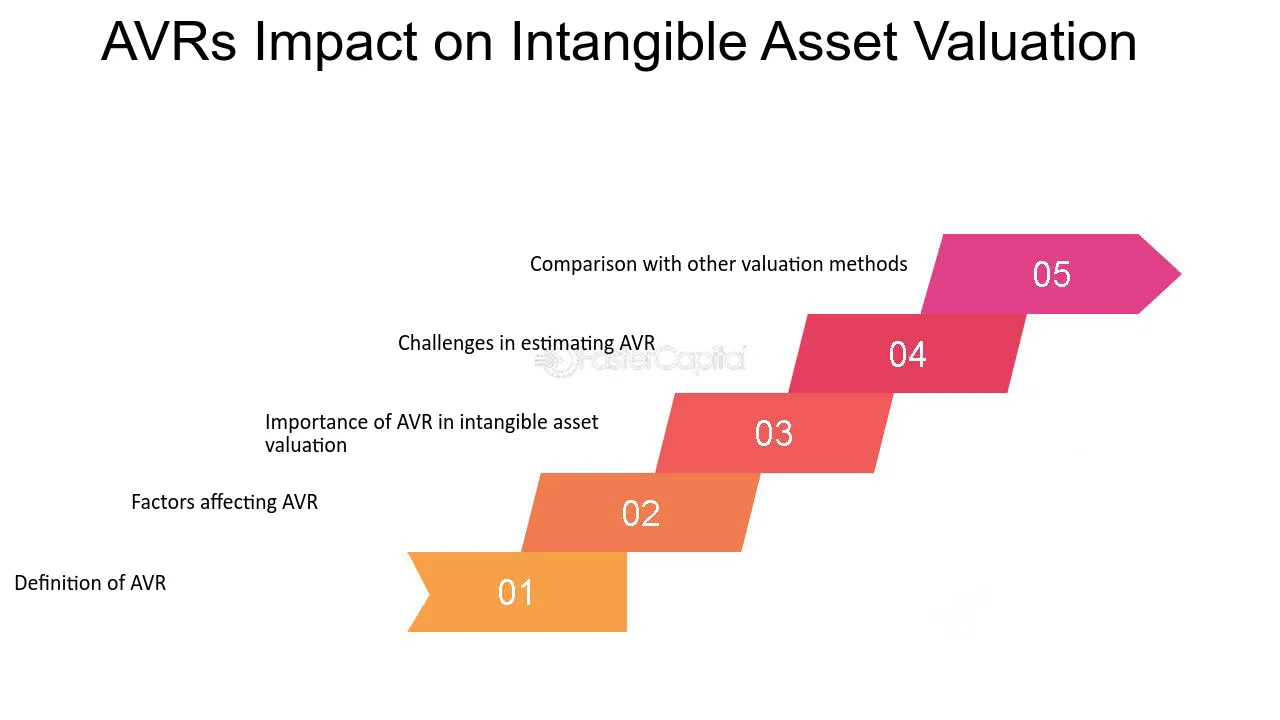
AVRs Impact on Intangible Asset Valuation - Goodwill: AVR s Impact on Assessing the Value of Intangible Assets
8. Defining The Intangible Asset
Goodwill is a term that has been used in accounting for many years and it is an important concept that businesses need to understand. It is an intangible asset that represents the value of a business beyond its tangible assets. Goodwill is a measure of a company's reputation, brand recognition, and customer loyalty. It is considered to be an intangible asset because it cannot be seen or touched, but it is still an important part of a company's value. In this section, we will define goodwill and explain why it is important for businesses to understand.
1. Definition of Goodwill: Goodwill is the intangible asset that represents the value of a business beyond its tangible assets. It can be defined as the value of a company's reputation, brand recognition, and customer loyalty. Goodwill is created when a business has a strong brand image and a good reputation in the market. It is also created when a business has a loyal customer base that is willing to pay a premium for its products or services.
2. Importance of Goodwill: Goodwill is important for businesses because it helps to establish their reputation in the market. A strong reputation can help a business to attract new customers and retain existing ones. Goodwill is also important for investors because it represents the value of a company's intangible assets. Investors are interested in the value of goodwill because it can affect the price of a company's stock.
3. Examples of Goodwill: There are many examples of goodwill in the market. For example, Apple is a company that has a strong brand image and a good reputation in the market. Its customers are loyal and willing to pay a premium for its products. Another example is Coca-Cola, which has a strong brand image and a loyal customer base. Customers are willing to pay a premium for Coca-Cola products because of the company's reputation.
4. Factors that affect Goodwill: There are many factors that can affect the value of goodwill. Some of these factors include the company's brand image, reputation, customer loyalty, and market position. Changes in any of these factors can affect the value of goodwill.
5. Valuation of Goodwill: Valuing goodwill can be a complex process because it is an intangible asset. There are many methods that can be used to value goodwill, including the excess earnings method, the relief from royalty method, and the market capitalization method. Each method has its own advantages and disadvantages, and the method used will depend on the specific circumstances of the business.
Goodwill is an important concept that businesses need to understand. It is the intangible asset that represents the value of a business beyond its tangible assets. Goodwill is important for businesses because it helps to establish their reputation in the market, and it is important for investors because it represents the value of a company's intangible assets. Understanding the factors that affect goodwill and the methods used to value it is important for businesses and investors alike.
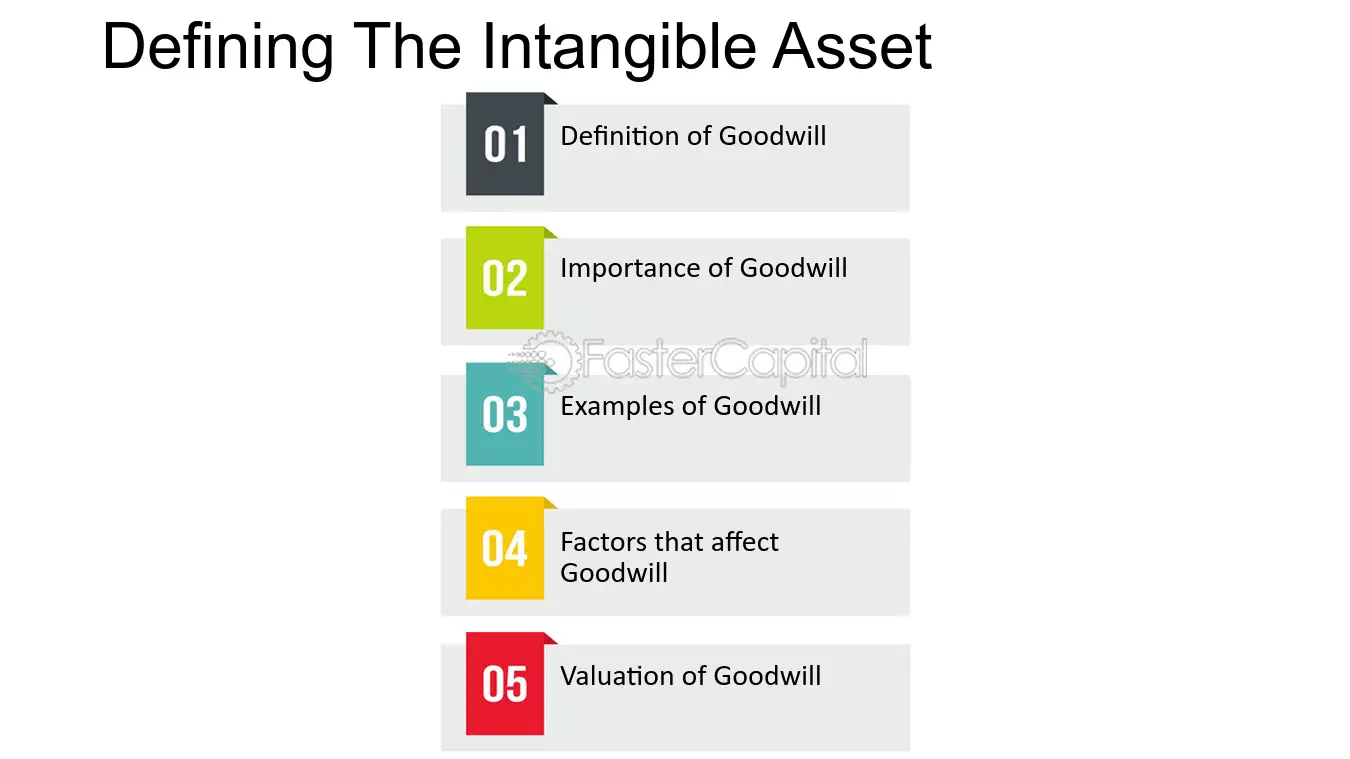
Defining The Intangible Asset - Goodwill: Evaluating the Intangible Value of Reputation and Branding
9. Factors that Affect Intangible Asset Values and Impairment Risks
A company's intangible assets, such as patents, trademarks, and copyrights, can be valuable contributors to its success. However, their values can be influenced by various factors, including market conditions, legal changes, and technological advancements. This can increase the risk of impairment, which occurs when the carrying value of the asset exceeds its recoverable amount. To minimize this risk, it is important to understand the factors that affect the values of intangible assets and the impairment risks they pose.
Here are some of the key factors that can affect the values of intangible assets and the risks of impairment:
1. Market conditions: Changes in the market can have a significant impact on the values of intangible assets. For example, a patent for a particular technology may lose value if a new, more efficient technology emerges. Similarly, a trademark may lose value if a company's brand reputation is damaged by negative publicity.
2. Legal changes: Changes in laws and regulations can also affect the values of intangible assets. For example, a change in patent laws may make it easier for competitors to replicate a company's technology, reducing the value of its patents. Changes in trademark laws may also impact the value of a company's branding efforts.
3. Technological advancements: Advances in technology can render certain intangible assets obsolete. For example, a company that holds patents for a particular type of software may see their value decrease if a new, more advanced software is developed.
4. Management decisions: Management decisions can also impact the values of intangible assets. For example, a company that invests heavily in a new product line may see the value of its patents increase if the product is successful.
5. Financial performance: The financial performance of a company can also impact the values of intangible assets. A company that is struggling financially may see the values of its intangible assets decrease as investors become more risk-averse.
In summary, there are many factors that can affect the values of intangible assets and the risks of impairment. Companies need to carefully monitor these factors to ensure that they are accurately valuing their intangible assets and minimizing the risks of impairment.
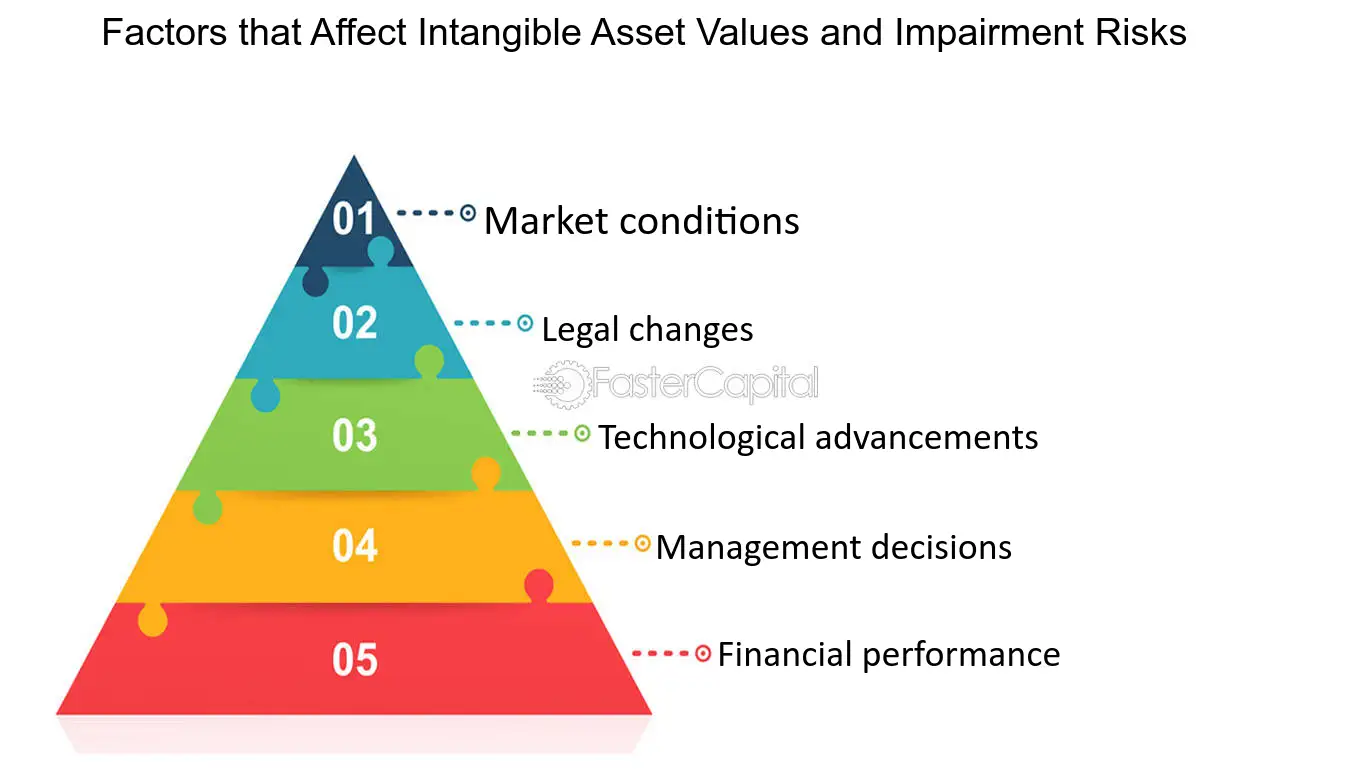
Factors that Affect Intangible Asset Values and Impairment Risks - Impairment Testing: Managing Intangible Amortization Risks
10. Reporting Intangible Asset Amortization
Intangible assets are an increasingly important part of many businesses, particularly in the technology and entertainment industries. When a company acquires an intangible asset, such as a patent or a copyright, it must account for that asset in its financial statements. One of the ways that companies account for intangible assets is by amortizing them over time. Amortization is the process of gradually reducing the value of an asset over its useful life. For intangible assets, this means that the asset's value is gradually reduced over the period in which the asset provides economic benefit to the company.
Reporting intangible asset amortization is an important part of a company's financial reporting. Here are some key points to keep in mind:
1. Intangible assets must be amortized over their useful lives. The useful life of an intangible asset is the period over which the asset is expected to provide economic benefit to the company. For example, if a company acquires a patent that is expected to be valid for 20 years, the useful life of the patent is 20 years, and the company must amortize the patent over that period.
2. The method of amortization can vary depending on the type of intangible asset. Some intangible assets are amortized on a straight-line basis, which means that the asset is amortized by the same amount each year. Other intangible assets are amortized on an accelerated basis, which means that more of the asset's value is amortized in the early years of its useful life.
3. The amount of intangible asset amortization that a company reports in its financial statements can have a significant impact on its financial performance. For example, if a company has a large amount of intangible asset amortization, its net income may be lower than it would be if the company did not have those expenses.
4. Intangible asset amortization is a non-cash expense, which means that it does not involve an actual cash outlay. However, it is still an important expense to consider when analyzing a company's financial performance.
Overall, reporting intangible asset amortization is an important part of a company's financial reporting. By understanding the key points outlined above, investors and analysts can gain a better understanding of a company's financial performance and the impact that intangible assets have on that performance.

Reporting Intangible Asset Amortization - Intangible Asset Acquisitions: Implications for Amortization
11. Reporting and Disclosing Intangible Asset Amortization
Intangible assets have become increasingly important in today's knowledge-based economy, as they represent a significant portion of a company's value. Amortization of intangible assets is a process of gradually expensing the cost of these assets over their useful life. In this blog section, we will discuss the reporting and disclosing of intangible asset amortization, which is an important aspect of financial reporting for any company that holds intangible assets.
1. Reporting Intangible Asset Amortization
Companies are required to report their intangible asset amortization in their financial statements. The amortization expense is reported on the income statement and is deducted from the revenue to arrive at the net income. The amount of amortization expense is also reported on the balance sheet, as a reduction in the carrying value of the intangible asset.
2. Disclosing Intangible Asset Amortization
In addition to reporting the amortization expense, companies are also required to disclose certain information about their intangible assets in the notes to the financial statements. This includes the total carrying amount of the intangible assets, the amortization expense for the current year, and the estimated future amortization expense for the next five years.
3. Options for Disclosing Intangible Asset Amortization
There are several options for disclosing intangible asset amortization in the notes to the financial statements. One option is to disclose the total amount of amortization expense for the current year and the estimated future amortization expense for the next five years. Another option is to disclose the amortization expense for each individual intangible asset, along with the estimated useful life of each asset.
4. Comparison of Options
Both options have their advantages and disadvantages. Disclosing the total amount of amortization expense is simpler and easier to understand, but it does not provide detailed information about individual intangible assets. Disclosing the amortization expense for each individual intangible asset is more detailed, but it can be more complex and time-consuming.
5. Best Option
The best option for disclosing intangible asset amortization depends on the nature of the company's intangible assets and the needs of the users of the financial statements. If the company has a large number of intangible assets with different useful lives, it may be more useful to disclose the amortization expense for each individual asset. However, if the company has a small number of intangible assets with similar useful lives, it may be more useful to disclose the total amount of amortization expense.
Reporting and disclosing intangible asset amortization is an important aspect of financial reporting for any company that holds intangible assets. Companies should carefully consider their options for disclosing this information and choose the best option based on the nature of their intangible assets and the needs of the users of the financial statements.
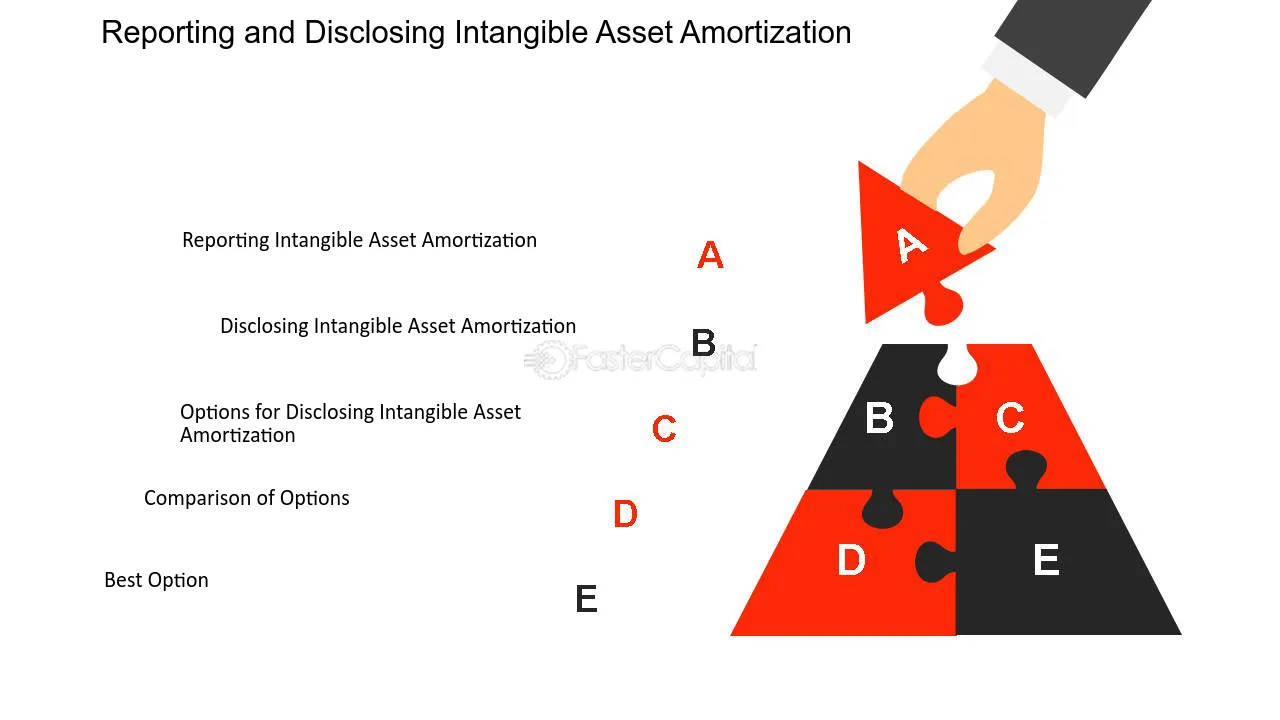
Reporting and Disclosing Intangible Asset Amortization - Intangible Asset Amortization: A Unit of Production Approach
12. Causes of Intangible Asset Devaluation
Intangible assets are the backbone of many businesses, and they account for a significant portion of the company's value. However, these assets can lose their value over time, and this is known as intangible asset devaluation. There are many reasons why intangible assets can lose their value, and it is essential for companies to understand these causes to avoid any significant losses. In this blog, we will explore the various causes of intangible asset devaluation and the methods that companies can use to write down these assets.
1. Technological Advancements
One of the main causes of intangible asset devaluation is technological advancements. With the rapid pace of innovation, many companies find that their once-valuable intangible assets are no longer relevant or useful. For example, a software company may have invested heavily in a particular technology that is now obsolete due to newer and more advanced technologies. As a result, the company's intangible assets lose value, and they may need to write them down.
2. Changes in Consumer Preferences
Consumer preferences can also play a significant role in intangible asset devaluation. As consumer preferences change, a company's intangible assets may no longer be in demand, and their value may decline. For example, a fashion company that invested heavily in a particular brand may find that the brand is no longer popular with consumers, and as a result, the brand loses value.
3. Economic Downturns
Economic downturns can also lead to intangible asset devaluation. During an economic recession, companies may need to cut costs, which can include writing down intangible assets. Moreover, a recession can lead to reduced demand for a company's products or services, which can negatively impact the value of their intangible assets.
4. Legal and Regulatory Changes
Legal and regulatory changes can also cause intangible asset devaluation. For example, a company that holds a patent may find that the patent is no longer enforceable due to changes in patent law. In this case, the value of the patent would decline, and the company may need to write it down.
5. Poor Management
Poor management can also lead to intangible asset devaluation. When a company fails to manage its intangible assets properly, they can lose value over time. For example, a company that fails to protect its intellectual property may find that its patents, trademarks, or copyrights lose value due to infringement.
There are many causes of intangible asset devaluation, and companies must be aware of these causes to avoid significant losses. Technological advancements, changes in consumer preferences, economic downturns, legal and regulatory changes, and poor management are some of the main causes of intangible asset devaluation. To write down these assets, companies can use various methods, including the cost method, market method, and income method. Ultimately, the best method will depend on the specific circumstances of the company and the intangible asset in question.
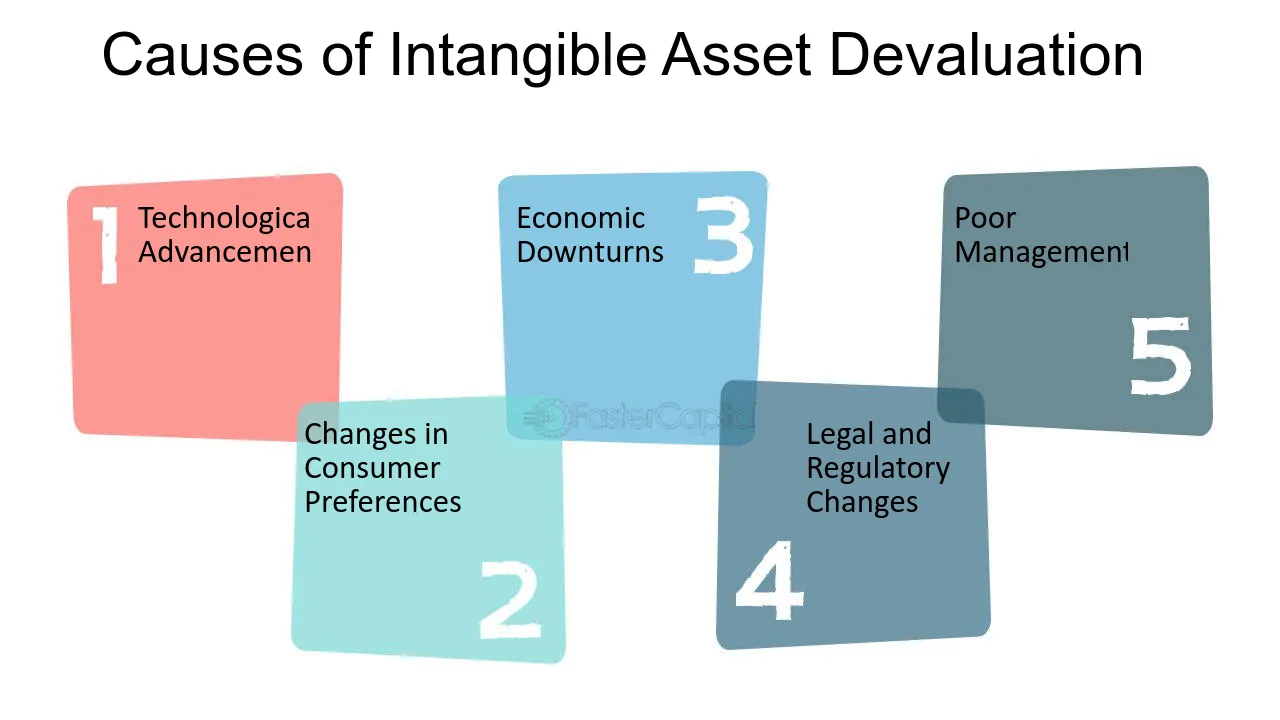
Causes of Intangible Asset Devaluation - Intangible asset devaluation: Exploring Writedown Methods
13. Impacts of Intangible Asset Devaluation on Financial Statements
Intangible assets are essential to the success of many businesses, including patents, trademarks, copyrights, and goodwill. However, the value of these assets can fluctuate depending on various factors, including market conditions, changes in technology, and changes in management. When the value of these assets decreases, it can have a significant impact on the financial statements of a company. In this section, we will explore the impacts of intangible asset devaluation on financial statements.
Intangible assets are recorded on the balance sheet at their fair value. When the value of these assets decreases, it leads to a decrease in the total assets of the company. This decrease can affect the company's ability to obtain financing and may lead to a breach of loan covenants. Additionally, it can lead to a decrease in the market value of the company's stock.
2. Impacts on Income Statement:
Intangible asset devaluation can also impact the income statement of a company. When the value of these assets decreases, it leads to a decrease in amortization expense. This decrease can improve the company's profitability, but it also indicates that the company is not able to generate the same level of revenue from its intangible assets.
3. Impacts on cash Flow statement:
Changes in the value of intangible assets can also impact the cash flow statement of a company. If the value of these assets decreases, it may lead to a decrease in cash flow from operating activities. This decrease can affect the company's ability to invest in future projects or pay dividends to shareholders.
4. Options for Dealing with Intangible Asset Devaluation:
There are several options available for companies to deal with intangible asset devaluation. One option is to write down the value of the assets on the balance sheet. This option is often used when the decrease in value is considered permanent. Another option is to conduct impairment tests to determine if the decrease in value is temporary or permanent. If the decrease is temporary, the company can continue to carry the assets at their original value.
5. Best Option:
The best option for dealing with intangible asset devaluation depends on the specific circumstances of the company. If the decrease in value is considered permanent, writing down the value of the assets on the balance sheet is the best option. However, if the decrease is temporary, conducting impairment tests is the best option. This approach allows the company to continue to carry the assets at their original value while still acknowledging the decrease in value.
Intangible asset devaluation can have a significant impact on a company's financial statements. It is essential for companies to understand the impacts of these devaluations and the options available for dealing with them. By choosing the best option for their specific circumstances, companies can mitigate the impacts of intangible asset devaluation on their financial statements.
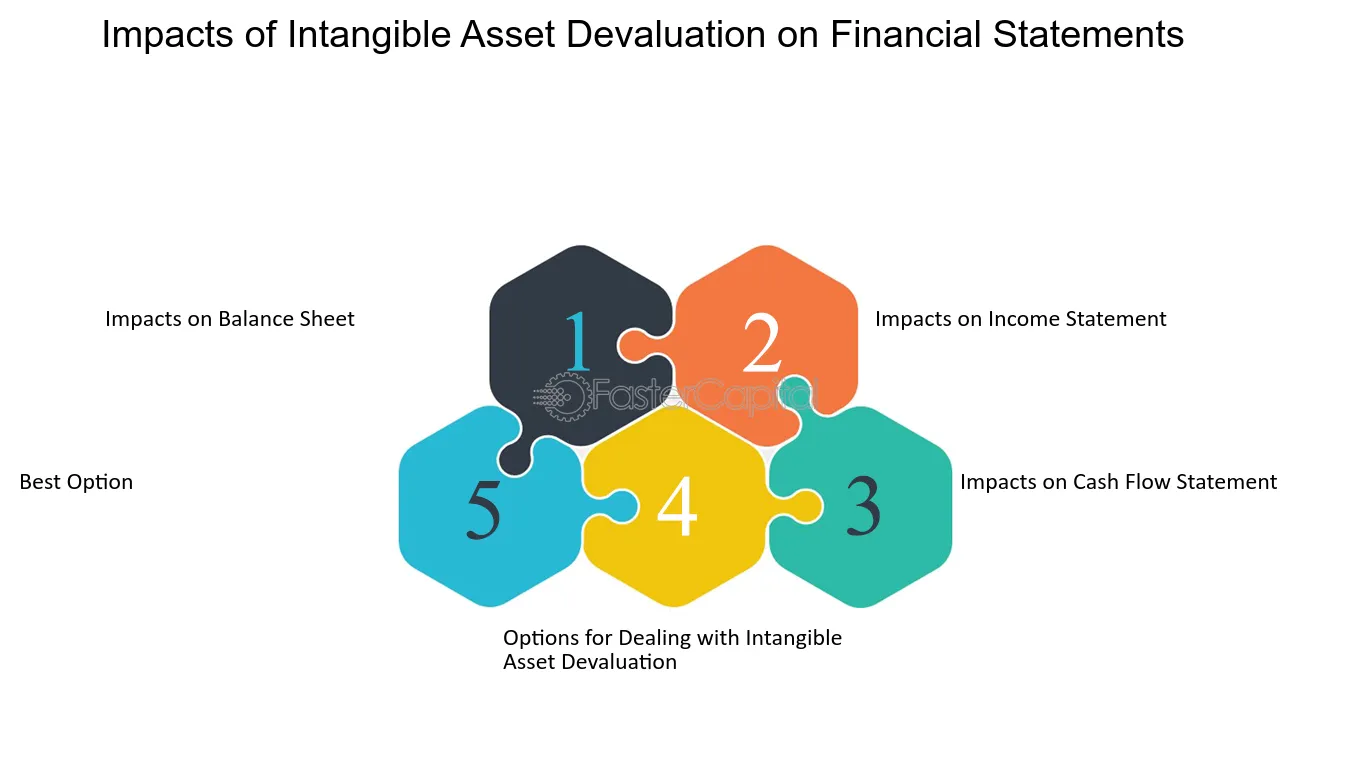
Impacts of Intangible Asset Devaluation on Financial Statements - Intangible asset devaluation: Exploring Writedown Methods
14. Understanding the Importance of Intangible Asset Valuation
Understanding the importance of intangible asset valuation is crucial for businesses in today's knowledge-based economy. While tangible assets such as buildings, machinery, and inventory are easily quantifiable and accounted for, intangible assets pose a unique challenge due to their non-physical nature. Intangible assets encompass a wide range of valuable resources, including intellectual property, brand reputation, customer relationships, and proprietary technology. These intangibles often play a significant role in driving a company's competitive advantage and long-term success.
From a financial perspective, accurately valuing intangible assets is essential for several reasons. Firstly, it allows businesses to make informed decisions regarding mergers and acquisitions, licensing agreements, or joint ventures. Without a clear understanding of the value of intangibles involved in such transactions, companies risk overpaying or undervaluing these assets, potentially leading to unfavorable outcomes. Secondly, proper valuation of intangibles enables organizations to effectively manage their balance sheets and accurately reflect their true worth. This is particularly important for investors and stakeholders who rely on financial statements to assess a company's overall health and potential for future growth.
From an operational standpoint, understanding the value of intangible assets can help businesses allocate resources more efficiently. For instance, by identifying which intangibles contribute the most to revenue generation or customer loyalty, companies can prioritize investments in those areas to maximize returns. Additionally, knowing the value of intangibles can aid in strategic decision-making by providing insights into market positioning and competitive advantages.
To delve deeper into the importance of intangible asset valuation, let us explore some key points:
1. Identifying hidden value: Intangible assets often hold hidden value that may not be immediately apparent. For example, a well-established brand name can command higher prices for products or services compared to lesser-known competitors. By valuing these intangibles accurately, businesses can unlock this hidden value and leverage it to gain a competitive edge.
2. Risk management: Intangible asset valuation plays a crucial role in risk assessment and mitigation. For instance, if a company heavily relies on a single patent for its revenue stream, understanding the value of that patent becomes vital to assess the potential impact of expiration or infringement risks.
3. compliance and regulatory requirements: Proper valuation of intangible assets is essential to comply with accounting standards and regulatory frameworks. Failure to accurately account for these assets can result in financial misstatements, legal issues, and reputational damage.
4. Investor confidence: Investors increasingly recognize the significance of intangible assets in determining a
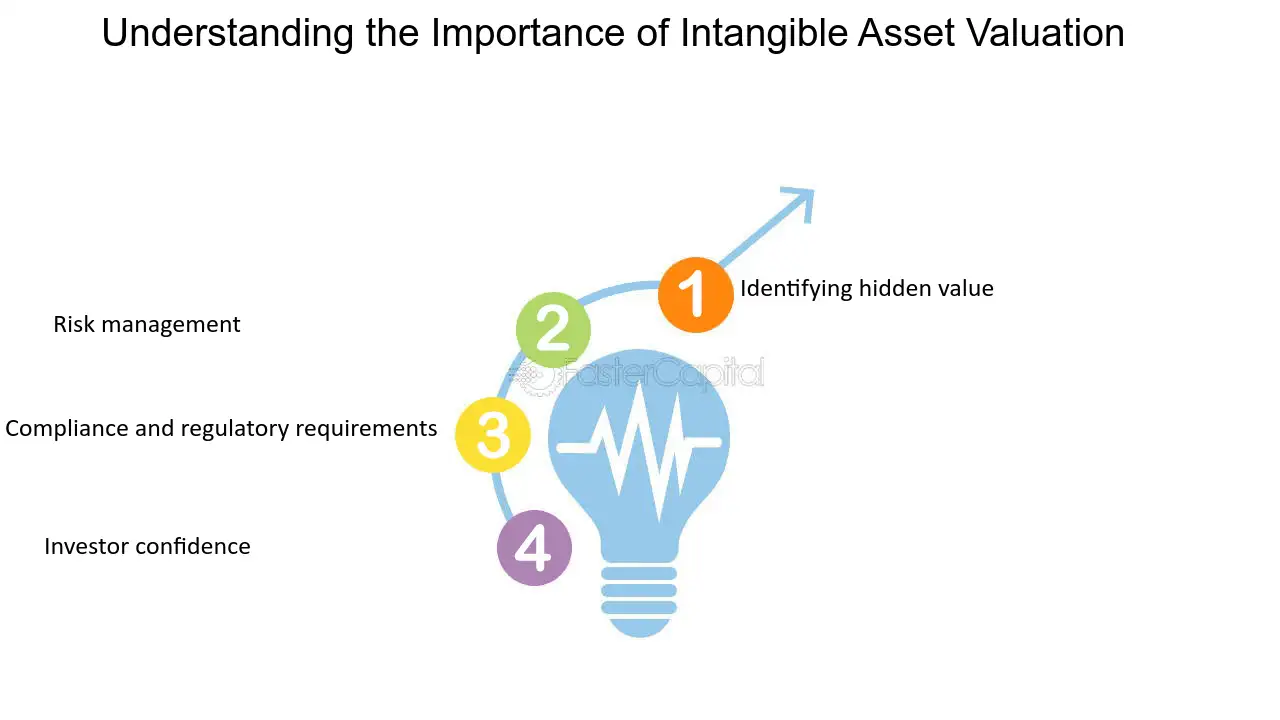
Understanding the Importance of Intangible Asset Valuation - Intangible asset valuation: Uncovering the true worth of goodwill
15. Examining Successful Intangible Asset Valuation Strategies
Case studies are an invaluable tool for understanding and analyzing successful intangible asset valuation strategies. By examining real-world examples, we can gain insights from different perspectives and learn from the experiences of others. These case studies provide a deeper understanding of the complexities involved in valuing intangible assets such as goodwill, patents, trademarks, and customer relationships. In this section, we will delve into some notable case studies that shed light on effective strategies for valuing intangible assets.
1. Case Study 1: The Coca-Cola Company
The Coca-Cola Company is renowned for its strong brand value, which is a significant intangible asset. In this case study, we explore how Coca-Cola's brand valuation strategy has contributed to its success. By consistently investing in marketing campaigns, sponsorships, and brand-building activities, Coca-Cola has managed to create a powerful brand image that resonates with consumers worldwide. This case study highlights the importance of considering brand value as a key component of intangible asset valuation.
2. Case Study 2: Google's Intellectual Property Portfolio
Google's intellectual property (IP) portfolio is a prime example of how patents and technology-related intangible assets can significantly impact a company's valuation. Through strategic acquisitions and internal innovation, Google has built an extensive IP portfolio that includes valuable patents and proprietary technologies. This case study emphasizes the need to assess the quality and market potential of a company's IP assets when valuing intangibles.
3. Case Study 3: Amazon's Customer Relationships
Amazon's success can be attributed in part to its strong customer relationships, which are considered valuable intangible assets. By leveraging data analytics and personalized recommendations, Amazon has created a loyal customer base that drives its revenue growth. This case study demonstrates the importance of evaluating customer relationships and their potential for generating future cash flows when valuing intangible assets.
4. Case Study 4: Nike's Brand Endorsements
Nike's endorsement deals with high-profile athletes have played a crucial role in building its brand value. By associating itself with successful athletes, Nike has created a strong brand image that resonates with sports enthusiasts worldwide. This case study highlights the significance of assessing the impact of brand endorsements and sponsorships on intangible asset valuation.
5. Case Study 5: Microsoft's Software Licensing Agreements
Microsoft's software licensing agreements are an essential intangible asset that contributes significantly to its valuation. Through strategic partnerships and licensing deals, Microsoft has expanded the reach of its software products, generating substantial revenue streams. This case
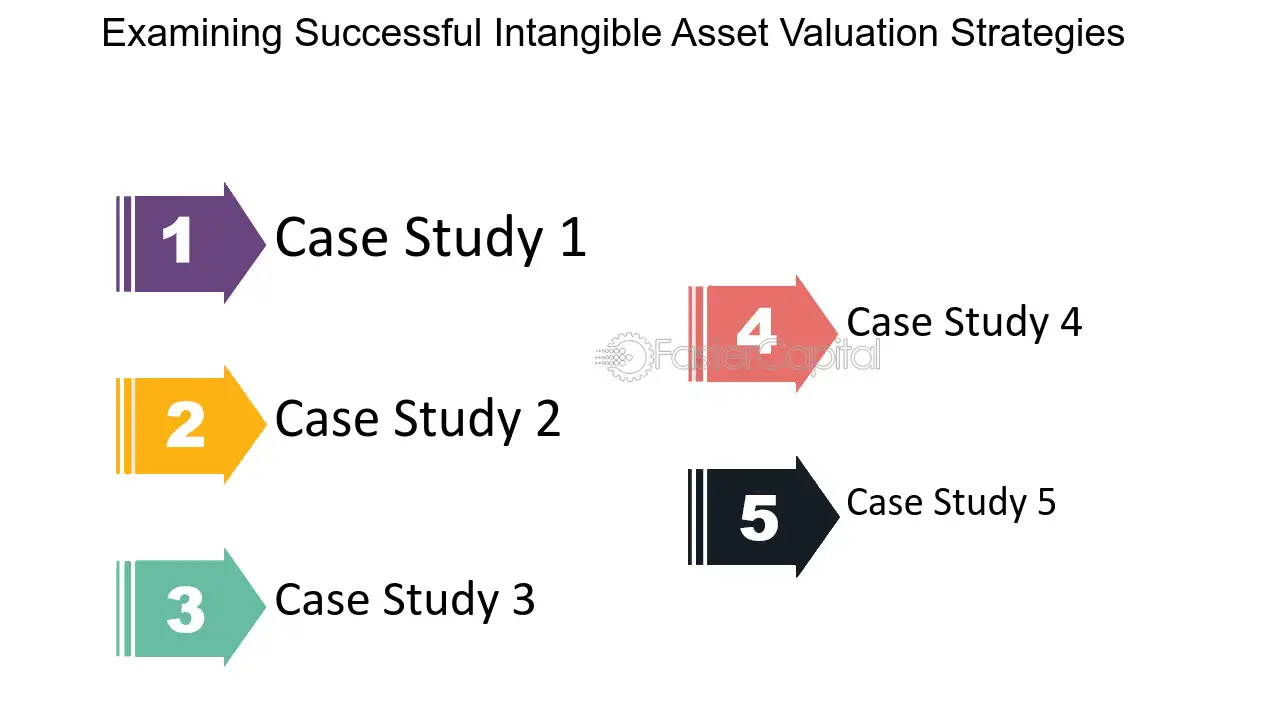
Examining Successful Intangible Asset Valuation Strategies - Intangible asset valuation: Uncovering the true worth of goodwill
16. Examples of Intangible Asset Valuation with Book Value per Common
When it comes to assessing the hidden value of intangible assets, one of the key metrics used is the book value per common share. This metric takes into account the total book value of a company's assets, including both tangible and intangible assets, and divides it by the number of outstanding common shares. The resulting figure provides an estimate of the value of each share of common stock based on the company's assets. In this section, we will take a closer look at some case studies that illustrate how this metric can be used to assess the value of a company's intangible assets.
1. Case Study 1: Coca-Cola
Coca-Cola is a prime example of a company with significant intangible assets. The Coca-Cola brand is one of the most valuable brands in the world, and its intangible assets also include patents, trademarks, and proprietary technology. When we look at Coca-Cola's book value per common share, we see that it is significantly higher than its market price per share. This indicates that the market may not be fully valuing Coca-Cola's intangible assets. In this case, investors who recognize the value of Coca-Cola's intangible assets may see an opportunity to buy the stock at a discount.
2. Case Study 2: Amazon
Amazon is another company with significant intangible assets, including its brand, patents, and proprietary technology. However, when we look at Amazon's book value per common share, we see that it is actually lower than its market price per share. This suggests that the market is valuing Amazon's intangible assets at a premium. In this case, investors who are considering buying Amazon stock need to carefully evaluate whether they believe the market is accurately valuing the company's intangible assets.
3. Case Study 3: Microsoft
Microsoft is a company that has undergone a significant transformation in recent years, moving from a focus on desktop software to cloud computing and other areas. When we look at Microsoft's book value per common share, we see that it has been steadily increasing over the past few years. This suggests that the market is recognizing the value of Microsoft's intangible assets, including its brand, patents, and proprietary technology. In this case, investors who are considering buying Microsoft stock may see an opportunity to invest in a company that is successfully leveraging its intangible assets to drive growth.
4. Case Study 4: Apple
Apple is a company that is often cited as an example of how intangible assets can drive significant value. Apple's brand is one of the most valuable in the world, and its intangible assets also include patents, trademarks, and proprietary technology. When we look at Apple's book value per common share, we see that it is significantly higher than its market price per share. This suggests that the market may not be fully valuing Apple's intangible assets. In this case, investors who recognize the value of Apple's intangible assets may see an opportunity to buy the stock at a discount.
5. Comparing the Options
When we compare these case studies, we see that there is no one-size-fits-all approach to assessing the value of intangible assets. In some cases, the market may undervalue a company's intangible assets, while in other cases, it may overvalue them. Investors who are considering buying stock in a company with significant intangible assets need to carefully evaluate the company's book value per common share, as well as other factors such as the company's growth prospects and competitive position. By taking a comprehensive approach to assessing a company's value, investors can make informed decisions about whether to buy or sell its stock.
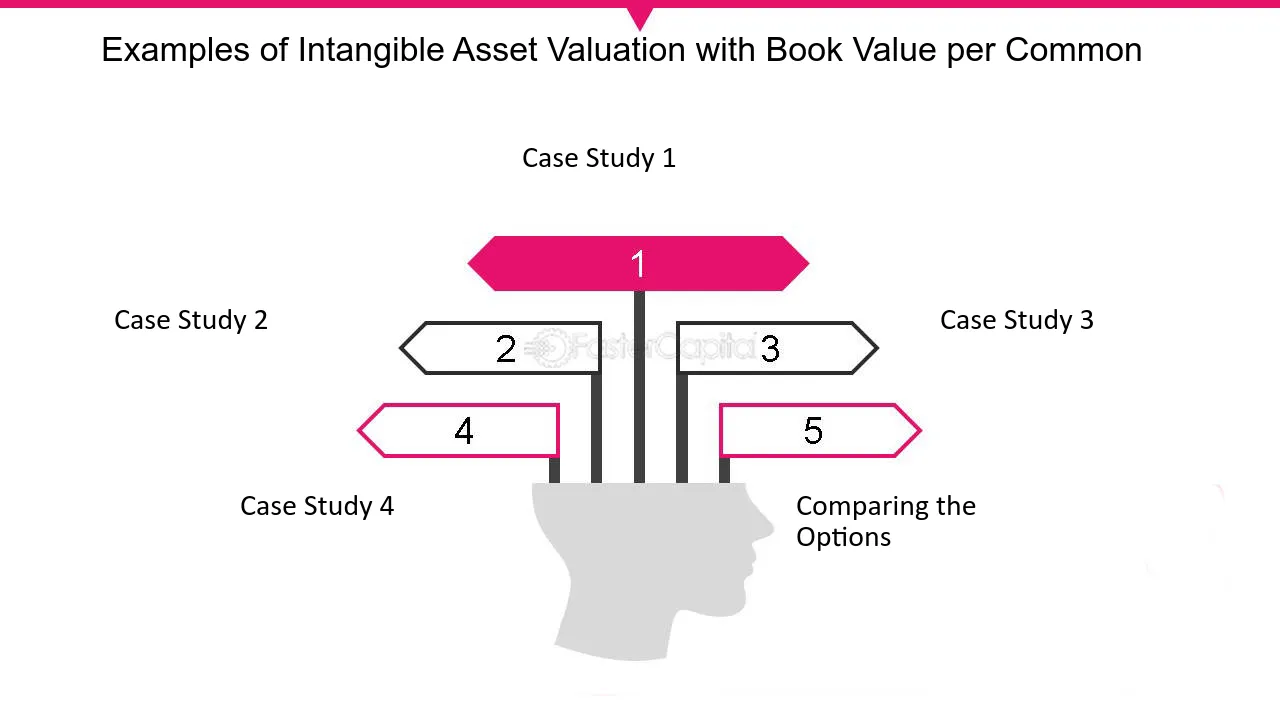
Examples of Intangible Asset Valuation with Book Value per Common - Intangible assets: Assessing Hidden Value with Book Value per Common
17. Cultivating a Strong Organizational Culture as an Intangible Asset
In today's highly competitive business landscape, companies are constantly seeking ways to gain a competitive edge. While financial assets and tangible resources play a crucial role in driving growth, it is essential not to overlook the power of intangible assets. These intangible assets, such as brand reputation, intellectual property, and organizational culture, can often be the differentiating factor that sets successful companies apart from their competitors. In this section, we will delve into the significance of cultivating a strong organizational culture as an intangible asset and explore how it can contribute to the overall growth and success of a company.
1. fostering a Sense of belonging and Purpose:
A strong organizational culture creates a sense of belonging and purpose among employees, leading to higher levels of engagement and motivation. When employees feel connected to the company's values and vision, they are more likely to go the extra mile, resulting in increased productivity and innovation. For example, companies like Google and Zappos have successfully cultivated a culture of innovation and employee empowerment, which has propelled them to become industry leaders.
2. attracting and Retaining Top talent:
Organizational culture plays a pivotal role in attracting and retaining top talent. In today's job market, prospective employees are not only looking for competitive compensation packages but also for a work environment that aligns with their values and provides a sense of fulfillment. A strong culture acts as a magnet, attracting individuals who resonate with the company's mission and values. Moreover, it helps retain existing employees by fostering a positive work environment and promoting employee satisfaction. For instance, companies like Netflix and Patagonia have built a reputation for their unique cultures, which has enabled them to attract and retain top talent in their respective industries.
3. Driving Innovation and Adaptability:
A strong organizational culture promotes a mindset of innovation and adaptability. When employees feel empowered to take risks and think outside the box, they are more likely to generate new ideas and drive innovation within the company. This culture of innovation allows companies to stay ahead of the curve and adapt to rapidly changing market conditions. Take the example of Apple, where a strong culture of innovation has been instrumental in their ability to consistently introduce groundbreaking products that disrupt the market.
4. enhancing Customer experience:
Organizational culture also has a direct impact on the customer experience. When employees are aligned with the company's values and committed to delivering exceptional service, it translates into a positive interaction for customers. A strong culture that prioritizes customer-centricity can create a competitive advantage by fostering customer loyalty and advocacy. Companies like Amazon and Southwest Airlines have built a strong reputation for their customer-centric cultures, which has contributed to their success and growth.
5. Nurturing Collaboration and Teamwork:
A strong organizational culture fosters collaboration and teamwork, enabling employees to work together towards a common goal. When employees feel a sense of camaraderie and trust within their teams, it leads to improved communication, knowledge sharing, and problem-solving capabilities. For example, companies like Pixar and IDEO have cultivated a culture that values collaboration and creativity, resulting in highly successful and innovative projects.
A strong organizational culture can be a valuable intangible asset that drives growth and success. By fostering a sense of belonging, attracting top talent, driving innovation, enhancing the customer experience, and nurturing collaboration, companies can leverage their culture to gain a competitive edge in the marketplace. As businesses continue to prioritize intangible assets, it is crucial to recognize the immense value of cultivating a strong organizational culture as an intangible asset.
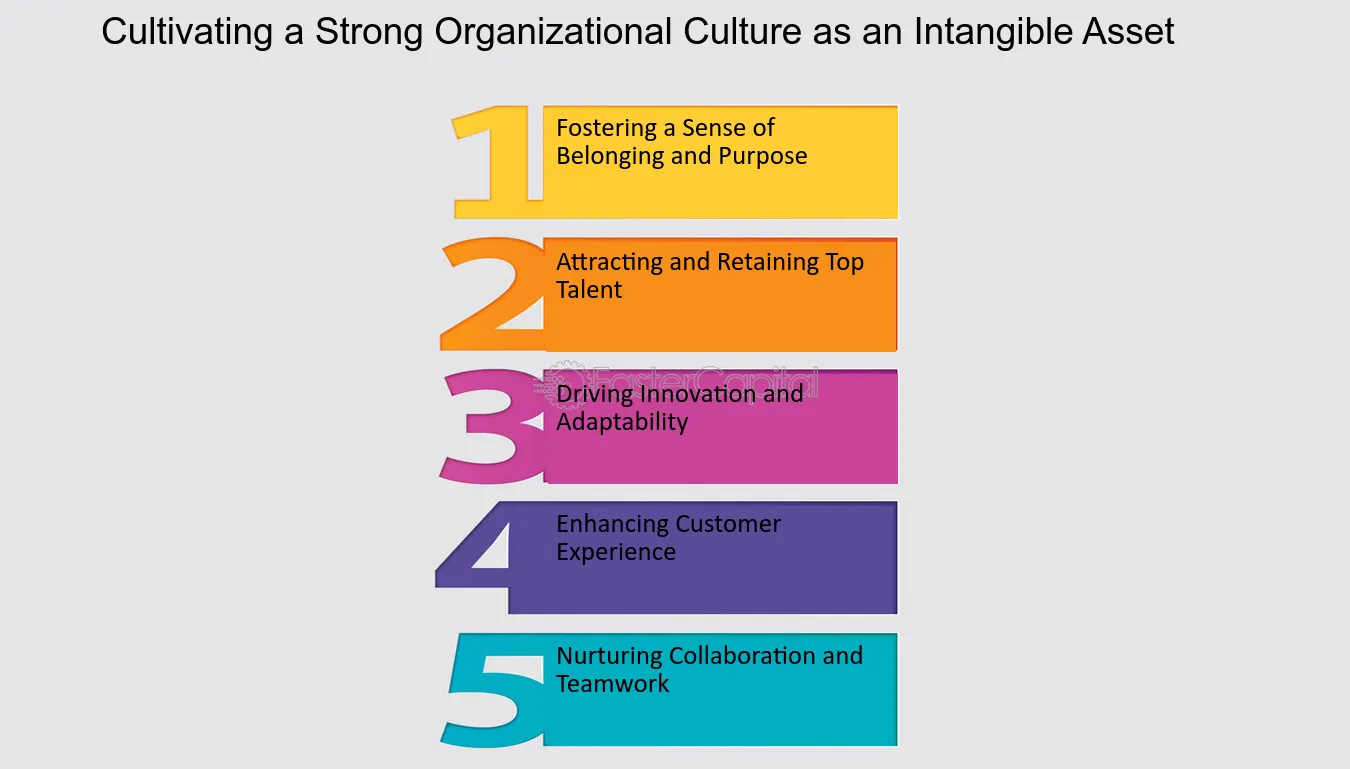
Cultivating a Strong Organizational Culture as an Intangible Asset - Intangible assets: Leveraging Intangible Non Financial Assets for Growth
18. Legal Considerations for Intangible Asset Management
Intangible assets are valuable assets that do not have physical existence, such as intellectual property, goodwill, and brand recognition. As such, managing intangible assets requires careful consideration of legal issues that may arise. Failure to address legal issues can lead to lost value, litigation, or even loss of rights to the asset. Therefore, it is crucial to consider legal considerations when managing intangible assets.
1. Identify and Protect Your Intangible Assets: Identifying and protecting your intangible assets is the first step towards effective management. This includes registering trademarks, copyrights, patents, and trade secrets. By doing this, you can prevent others from using your intellectual property without permission and protect the value of your assets.
2. Conduct due diligence: Conducting due diligence is another essential step. This involves researching your intangible assets to identify any potential legal issues. For example, if you are acquiring a company, you should conduct due diligence to ensure that the company has the necessary intellectual property rights to its assets. Failure to conduct due diligence can result in legal disputes or loss of value.
3. Draft Contracts: Drafting contracts that outline the terms of use for your intangible assets is also crucial. For example, licensing agreements can help you generate revenue from your assets while controlling their use. The contracts should be clear and legally binding to avoid misunderstandings and legal disputes.
4. Monitor Your Assets: Monitoring your intangible assets is crucial to prevent their misuse. This includes monitoring the internet for any infringement on your intellectual property rights. For example, if you own a trademark, you should monitor the internet for any unauthorized use of your mark.
5. Enforce Your Rights: Enforcing your rights is essential to protect the value of your intangible assets. This involves taking legal action against any infringement on your intellectual property rights. For example, if someone is using your trademark without permission, you can file a lawsuit to stop them from doing so.
Legal considerations are crucial when managing intangible assets. Identifying and protecting your assets, conducting due diligence, drafting contracts, monitoring your assets, and enforcing your rights are all important steps towards effective management. By considering these legal issues, you can protect the value of your intangible assets and avoid legal disputes.
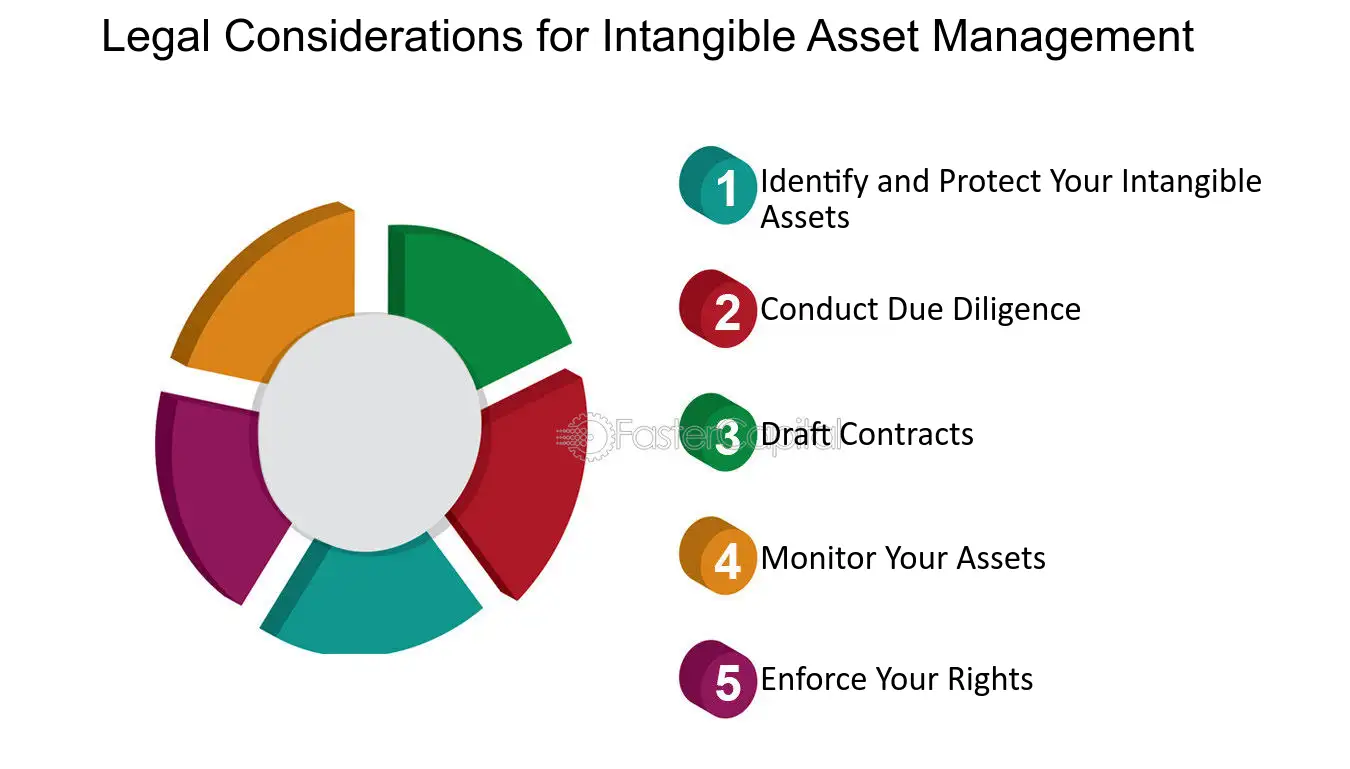
Legal Considerations for Intangible Asset Management - Intangible assets: The Hidden Value in Non Physical Assets
19. A Significant Intangible Asset in Book Value Reduction
1. Goodwill: A Significant Intangible Asset in Book Value Reduction
Goodwill is a key intangible asset that often plays a significant role in book value reduction. It represents the premium paid by a company to acquire another business above its net tangible assets. While goodwill is not a physical asset, it holds immense value for a company as it encompasses the intangible benefits associated with the acquired business, such as brand reputation, customer loyalty, and intellectual property. In this section, we will delve into the importance of goodwill in book value reduction and explore some examples, tips, and case studies to gain a deeper understanding of its impact.
2. The Nature of Goodwill
Goodwill arises when a company acquires another business and pays more than the fair value of its identifiable net assets. It is classified as an intangible asset on the balance sheet and is subject to periodic impairment testing. Goodwill is not amortized like other intangible assets but is instead tested for impairment at least annually or whenever there are indications of potential impairment. If the carrying value of goodwill exceeds its recoverable amount, a write-down is necessary, resulting in a reduction of the company's book value.
3. Factors Influencing Goodwill Impairment
Various factors can lead to goodwill impairment, including changes in market conditions, adverse economic events, shifts in consumer preferences, or a decline in the acquired business's performance. For example, if a company acquires a technology firm with a strong brand presence, but advancements in the industry render the acquired technology obsolete, the value of the goodwill associated with that acquisition may diminish. Similarly, if a company experiences a significant decline in its market share or faces reputational damage, it may trigger the need for goodwill impairment testing.
4. Tips to Mitigate Goodwill Impairment Risks
To minimize the risks associated with goodwill impairment and subsequent book value reduction, companies can adopt several strategies. Firstly, conducting thorough due diligence before acquiring a business is crucial. This includes assessing the sustainability of the acquired business's competitive advantage and estimating potential synergies. Secondly, regularly monitoring market and industry trends can help identify any early warning signs of impairment. It is also essential to maintain transparent financial reporting practices and provide sufficient disclosures regarding the assumptions and judgments made during goodwill impairment testing.
5. Case Study: The AOL-Time Warner Merger
The AOL-Time Warner merger, which took place in 2000, serves as a notable example of goodwill impairment and subsequent book value reduction. AOL, an internet service provider, purchased Time Warner, a media conglomerate, for a staggering $165 billion. However, the merger failed to realize the anticipated synergies and faced challenges due to the dot-com bubble burst and changes in the media landscape. Consequently, AOL-Time Warner recorded a goodwill impairment charge of approximately $99 billion in 2002, one of the largest write-downs in corporate history. This impairment significantly reduced the company's book value and had lasting implications for its financial performance.
6. Conclusion
Goodwill plays a crucial role in book value reduction, as it represents the intangible benefits acquired through business acquisitions. Understanding the nature of goodwill, factors influencing its impairment, and implementing effective strategies to mitigate risks are vital for companies to maintain a healthy book value. The AOL-Time Warner case study serves as a reminder of the importance of accurately assessing the value of goodwill and the potential consequences of overestimating its worth. By carefully managing goodwill, companies can safeguard their financial health and ensure accurate reflection of their true value.
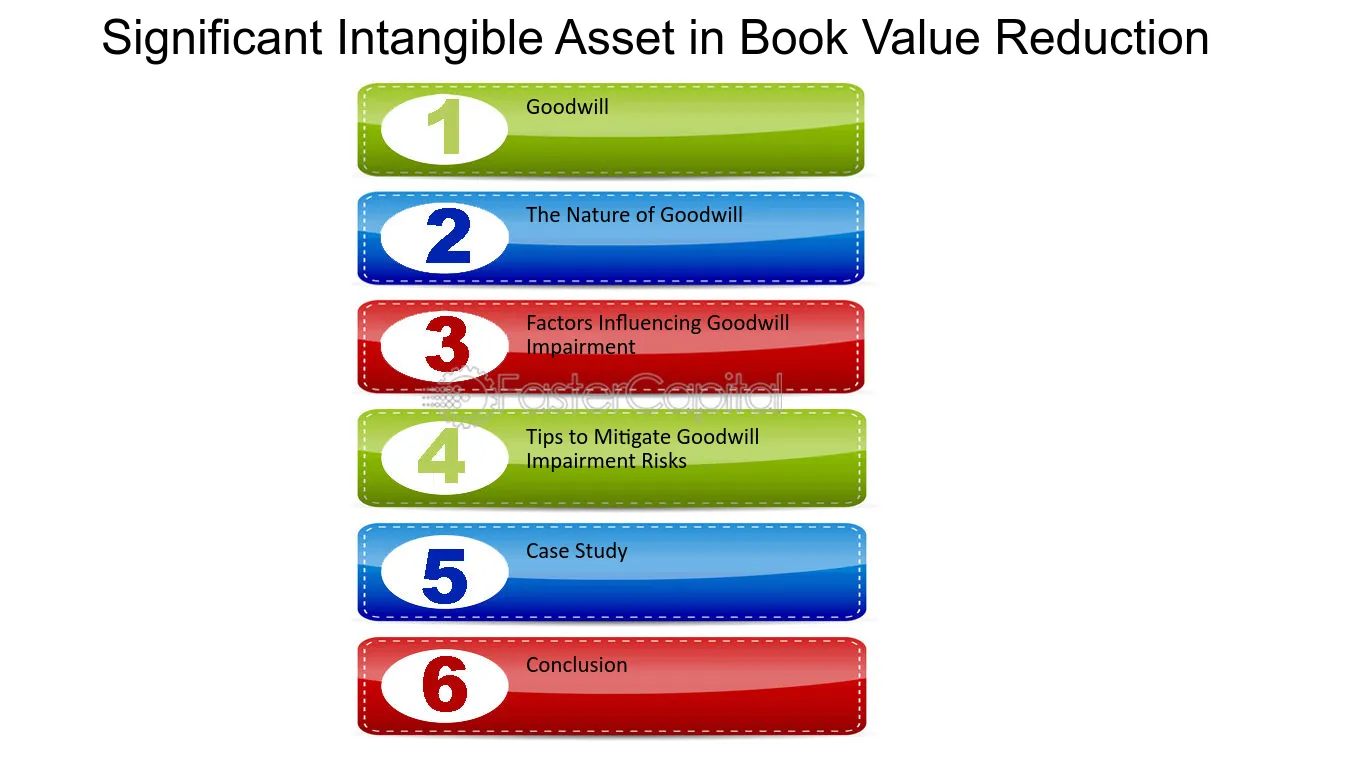
A Significant Intangible Asset in Book Value Reduction - Intangible Assets: The Intangible Side of Book Value Reduction
20. The Importance of Unveiling Intangible Asset Insights
Section 1: Unveiling the Hidden Gems
In the realm of market research, the focus has historically been on tangible assets – the physical properties, stocks, and monetary assets that are easily quantified and assessed. However, in today's rapidly evolving business landscape, intangible assets have emerged as equally, if not more, critical. These non-physical assets, such as intellectual property, brand reputation, and customer relationships, play a significant role in a company's overall value. Yet, their value remains largely concealed, making it imperative to unveil the insights they hold.
1. Recognizing the Intangible Asset Spectrum: Intangible assets come in various forms, from patents and copyrights to trademarks and goodwill. Different industries and businesses possess distinct types of intangible assets, each contributing differently to their worth. It's essential to understand this spectrum to prioritize effectively.
2. Quantifying the Unquantifiable: A challenge arises when attempting to quantify the value of intangible assets. Unlike tangible assets with concrete market values, intangibles rely on subjective estimations. Methods like cost, market, and income approaches are used to assess them. For instance, Apple's brand reputation, an intangible asset, is estimated to be worth billions.
3. Risks and Rewards of Unveiling: Companies that successfully unveil their intangible assets can experience substantial benefits, such as attracting investors, enhancing market positioning, and improving strategic decision-making. However, unveiling also poses risks, like potential imitation by competitors, making it essential to strike a balance.
4. Data-Driven Insights: One effective way to uncover intangible asset insights is through comprehensive data analysis. Companies can leverage big data and analytics tools to gain insights into customer sentiment, market trends, and competitive landscapes. For instance, social media sentiment analysis can reveal how a brand is perceived, offering valuable insights into its reputation.
Section 2: Measuring Intangible Assets
Understanding the value of intangible assets is one thing, but measuring them accurately is a whole new challenge. Companies have several options, each with its pros and cons.
1. Market Valuation: Assessing intangible assets based on their market value is suitable for assets like trademarks, which might have a readily available market price. However, this method can't capture the full value of assets like intellectual property, which is more challenging to trade in a market.
2. Cost Approach: This method entails calculating the costs incurred in creating an intangible asset, such as research and development expenses. While it provides a solid basis for valuation, it often fails to account for the asset's potential for future earnings.
3. Income Approach: The income approach estimates the value of intangible assets based on the income they generate. It's suitable for assets like patents with clear revenue streams but may be less accurate for assets with uncertain future returns.
4. Hybrid Methods: Many experts recommend using a combination of approaches to assess intangible assets comprehensively. For instance, combining the market and income approaches may provide a more accurate valuation for assets with uncertain markets but clear income potential.
Section 3: Protecting Intangible Assets
Once uncovered and measured, it's crucial to protect intangible assets. The following options are available:
1. Legal Protections: Trademarks, patents, and copyrights can be legally protected. For instance, Coca-Cola's secret formula is a closely guarded trade secret, legally protected from disclosure.
2. Reputation Management: Companies can invest in reputation management strategies to safeguard their brand's intangible value. Maintaining a positive image and addressing crises promptly can prevent reputational damage.
3. Cybersecurity: In the digital age, protecting intangible assets like proprietary software and customer databases from cyber threats is paramount. Implementing robust cybersecurity measures is essential.
4. Insurance: Some companies opt for intangible asset insurance, which can cover losses due to reputational damage or intellectual property infringement.
By understanding the importance of unveiling intangible asset insights, measuring their value, and protecting them, businesses can harness these hidden gems to drive growth and secure their competitive advantage in today's dynamic markets.
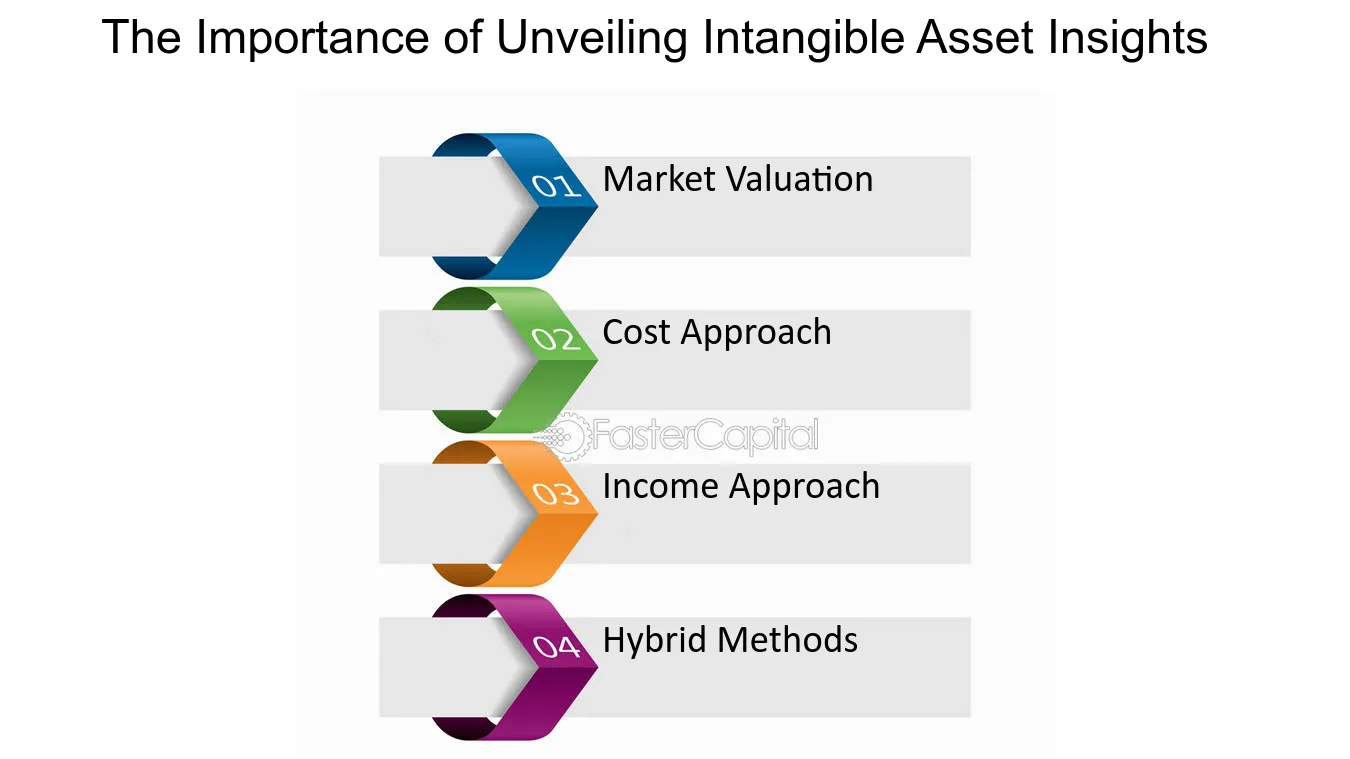
The Importance of Unveiling Intangible Asset Insights - Market Research Data: Unveiling Intangible Asset Insights
21. Unveiling Intangible Asset Insights for Business Success
Intangible assets are the hidden gems that every business has but often neglects. They are the non-physical assets that contribute to the value of a company, such as brand reputation, customer loyalty, intellectual property, and human capital. While tangible assets like buildings, equipment, and inventory can be easily measured, intangible assets are not so straightforward. However, understanding and leveraging intangible assets is critical for business success. In this section, we will delve into case studies that highlight the importance of intangible assets and how they can be used to gain a competitive advantage.
1. Case Study: Apple Inc.
Apple Inc. Is a prime example of a company that has leveraged its intangible assets to become one of the most successful companies in the world. The company's brand reputation is one of the strongest in the world, and its loyal customer base is a testament to this fact. Apple's brand is so powerful that it has become a status symbol, with people willing to pay a premium for its products. Additionally, Apple's intellectual property, such as patents and trademarks, has allowed the company to protect its innovations and prevent competitors from copying its ideas.
2. Case Study: Coca-Cola
Coca-Cola is another company that has successfully leveraged its intangible assets. The company's brand is recognized worldwide, and its products are sold in over 200 countries. Coca-Cola's brand is so strong that it has become synonymous with soft drinks. The company has also invested heavily in advertising and marketing, which has helped to create and maintain its brand reputation. Coca-Cola's intangible assets have allowed the company to dominate the soft drinks industry for over a century.
3. Case Study: Google
Google, now a subsidiary of Alphabet Inc., is a company that has built its success on its intangible assets. The company's search engine is one of the most powerful in the world, and its algorithms and data analytics have allowed it to provide users with relevant search results. Google's human capital is also a key intangible asset, with the company attracting some of the most talented engineers, data scientists, and marketers in the world. Google's intangible assets have allowed the company to dominate the search engine market and expand into other areas such as cloud computing, artificial intelligence, and self-driving cars.
4. Case Study: Kodak
Kodak is a cautionary tale of a company that failed to leverage its intangible assets and adapt to changing market conditions. The company was once a dominant player in the photography industry, with its brand and patents giving it a competitive advantage. However, Kodak failed to recognize the shift towards digital photography and was slow to adapt. The company's intangible assets became a liability, with its brand losing relevance and its patents becoming less valuable. Kodak filed for bankruptcy in 2012, a victim of its inability to leverage its intangible assets.
5. The Best Option
The case studies above illustrate the importance of intangible assets for business success. Companies that understand and leverage their intangible assets can gain a competitive advantage and create long-term value. The best option for businesses is to conduct a comprehensive intangible asset analysis to identify their key intangible assets and develop strategies to leverage them. This analysis should include identifying the company's brand reputation, intellectual property, human capital, and customer relationships. By understanding and leveraging their intangible assets, businesses can unlock their full potential and achieve sustainable growth.
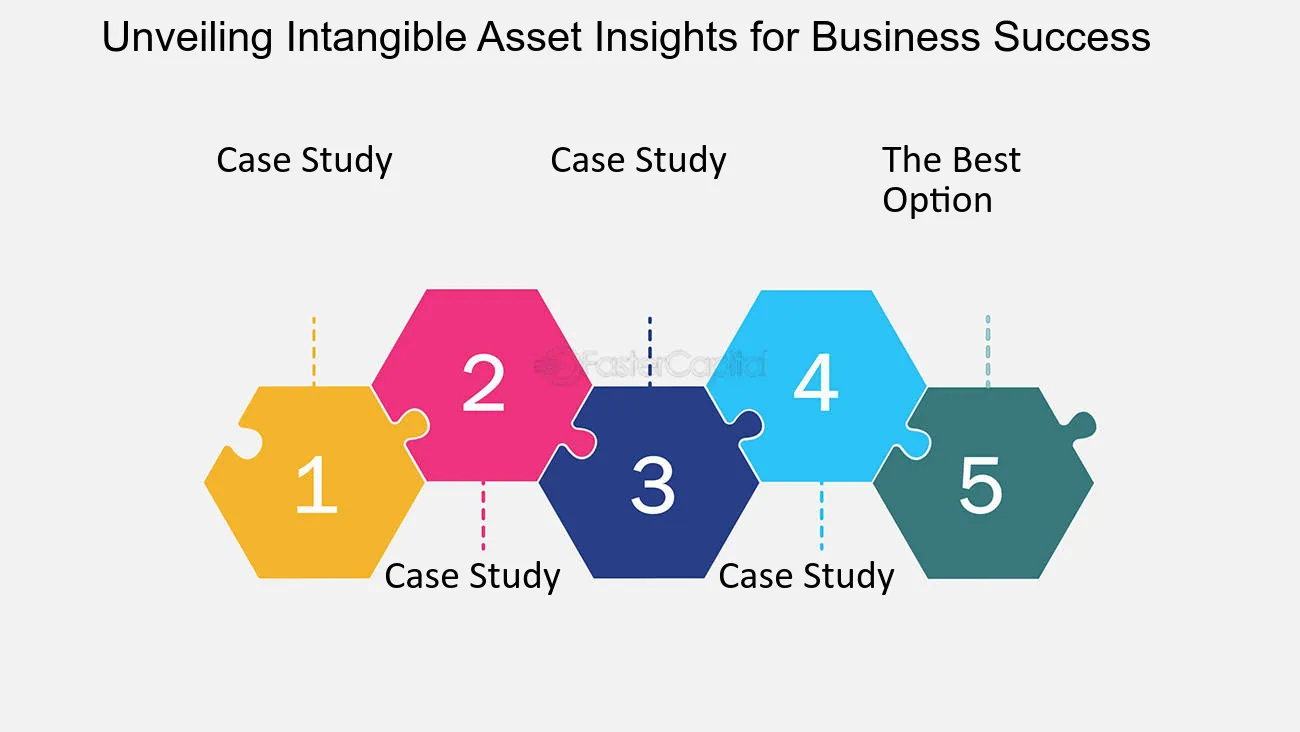
Unveiling Intangible Asset Insights for Business Success - Market Research Data: Unveiling Intangible Asset Insights
22. Future Trends in Unveiling Intangible Asset Insights
As the world becomes more digitally-driven, the importance of intangible assets continues to grow. In today's economy, intangible assets such as brand reputation, customer loyalty, and intellectual property are often more valuable than physical assets. However, measuring and understanding the value of these assets can be a challenge. Fortunately, advancements in technology and data analysis are making it easier to unveil insights into intangible assets. In this blog section, we will explore some of the future trends in uncovering intangible asset insights.
1. Artificial Intelligence (AI) and Machine Learning (ML)
AI and ML are revolutionizing the way we analyze data. These technologies can process vast amounts of data and identify patterns that would be impossible for humans to detect. In the context of intangible assets, AI and ML can be used to analyze social media sentiment, identify customer preferences, and predict future market trends. For example, a company can use AI to analyze customer reviews and identify areas for improvement in their product or service.
2. Blockchain Technology
Blockchain technology has the potential to revolutionize the way we track and manage intangible assets. By using a decentralized, secure ledger, blockchain can provide a transparent and tamper-proof record of ownership and usage of intangible assets. This can be particularly useful in industries such as music and art, where ownership and usage rights can be complex and difficult to track. For example, blockchain can be used to track the usage of copyrighted music and ensure that the appropriate royalties are paid to the owners.
3. Data Visualization
Data visualization tools are becoming increasingly sophisticated, making it easier to understand and interpret complex data. In the context of intangible assets, data visualization can be used to identify trends and patterns in customer behavior, brand reputation, and market trends. For example, a company can use data visualization to track the sentiment of social media mentions of their brand and identify areas where they need to improve their reputation.
4. Predictive Analytics
Predictive analytics can be used to forecast future trends and identify potential opportunities and risks. In the context of intangible assets, predictive analytics can be used to identify emerging market trends, predict customer behavior, and forecast changes in brand reputation. For example, a company can use predictive analytics to identify emerging trends in their industry and adjust their product or service offerings accordingly.
5. Collaborative Data Analysis
Collaborative data analysis involves bringing together multiple stakeholders to analyze and interpret data. This approach can be particularly useful in the context of intangible assets, where multiple stakeholders may have different perspectives on the value and usage of these assets. By bringing together stakeholders such as customers, employees, and investors, companies can gain a more comprehensive understanding of their intangible assets and how they can be leveraged for competitive advantage.
The future of uncovering intangible asset insights is exciting and full of potential. By leveraging advancements in technology and data analysis, companies can gain a deeper understanding of the value and usage of their intangible assets. Whether through AI and ML, blockchain technology, data visualization, predictive analytics, or collaborative data analysis, companies can gain a competitive advantage by unlocking the insights hidden in their intangible assets.

Future Trends in Unveiling Intangible Asset Insights - Market Research Data: Unveiling Intangible Asset Insights
23. Strategies for Maximizing ROI through Intangible Asset Amortization
When it comes to maximizing ROI, intangible assets such as technology patents can play a critical role in achieving this goal. However, many companies struggle to fully leverage these assets, often because they do not understand how to amortize them effectively. In this section, we will explore the strategies that companies can use to amortize their intangible assets and achieve maximum ROI.
From a legal perspective, amortizing intangible assets can be a complex process. Companies must navigate a variety of regulations and requirements, including tax laws, accounting rules, and industry-specific regulations. Additionally, the valuation of intangible assets can be challenging, as they often lack a clear market value. However, despite these challenges, amortizing intangible assets can provide significant benefits for companies that are willing to invest the time and resources necessary to do it right.
To help companies maximize ROI through intangible asset amortization, we have compiled a list of strategies that can be used to achieve this goal:
1. Conduct a thorough valuation of your intangible assets: Before you can effectively amortize your intangible assets, you need to have a clear understanding of their value. This requires a detailed valuation process that takes into account a range of factors, including market demand, industry trends, and your company's unique competitive advantage.
2. Develop a comprehensive amortization plan: Once you have a clear understanding of the value of your intangible assets, you can begin to develop an amortization plan that aligns with your overall financial goals. This plan should take into account factors such as tax implications, cash flow needs, and long-term growth objectives.
3. Consider outsourcing the amortization process: For many companies, the process of amortizing intangible assets can be overwhelming. In these cases, outsourcing the process to a third-party provider can be an effective solution. This approach allows companies to leverage the expertise of experienced professionals while freeing up internal resources for other critical tasks.
4. Leverage technology to streamline the process: Technology can play a critical role in streamlining the intangible asset amortization process. For example, specialized software can help companies track and manage their intangible assets, while automation tools can reduce the time and effort required to complete routine tasks.
By implementing these strategies, companies can effectively amortize their intangible assets and achieve maximum ROI. For example, a technology company that has developed a valuable patent can leverage these strategies to maximize the return on their investment and drive long-term growth. Ultimately, effective intangible asset amortization requires a combination of financial expertise, legal knowledge, and technology tools to be successful.
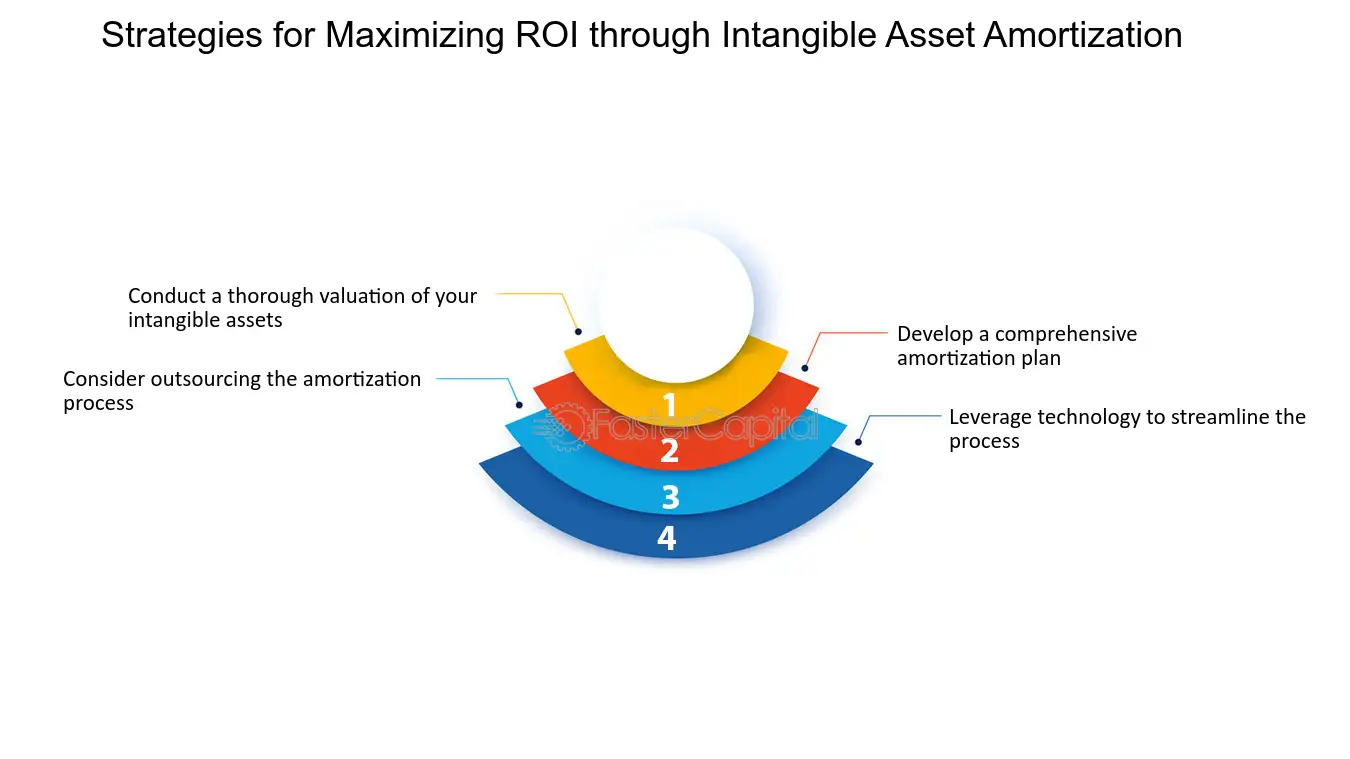
Strategies for Maximizing ROI through Intangible Asset Amortization - Maximizing ROI: Amortizing Intangibles in Technology Patents
24. Maintaining Intangible Asset Value
When it comes to navigating the complex world of goodwill impairment, one crucial aspect that cannot be overlooked is the value of intangible assets. These intangibles, such as brand reputation, customer relationships, patents, and intellectual property, often play a significant role in determining the overall value of a company. Therefore, it becomes imperative for organizations to adopt effective strategies to mitigate the risks associated with goodwill impairment and ensure the preservation of their intangible asset value.
From a financial perspective, maintaining the value of intangible assets can directly impact a company's bottom line. A decline in the value of these assets can lead to impairment charges, which not only affect reported earnings but also erode shareholder value. Additionally, from an operational standpoint, the loss of intangible asset value can result in decreased market competitiveness and hinder future growth prospects.
To address these risks and safeguard intangible asset value, organizations can employ various strategies:
1. Regularly assess and monitor intangible assets: Conducting periodic assessments of intangible assets allows companies to identify any potential impairments early on. By monitoring factors such as changes in market conditions, technological advancements, or shifts in consumer preferences, organizations can proactively respond to threats that may impact the value of their intangibles.
For example, consider a software development company that relies heavily on its proprietary technology for competitive advantage. To maintain the value of its intellectual property rights, the company regularly conducts audits to ensure compliance with copyright laws and monitors industry trends to stay ahead of emerging technologies that could render its software obsolete.
2. Invest in research and development (R&D): Continuous investment in R&D activities is crucial for businesses reliant on innovation-driven intangibles. By allocating resources towards developing new products or enhancing existing ones, companies can strengthen their competitive position and protect the value of their intangible assets.
For instance, a pharmaceutical company that holds patents for groundbreaking drugs must consistently invest in R&D to stay ahead of competitors and maintain the exclusivity of its intellectual property. This ongoing commitment to innovation not only preserves the value of existing intangibles but also creates opportunities for future growth.
3. Strengthen brand management and customer relationships: Intangible assets like brand reputation and customer relationships are often the most valuable assets for companies operating in consumer-driven industries. Organizations should focus on building strong brand equity through effective marketing strategies, maintaining consistent product quality, and delivering exceptional customer experiences.
Take the example of
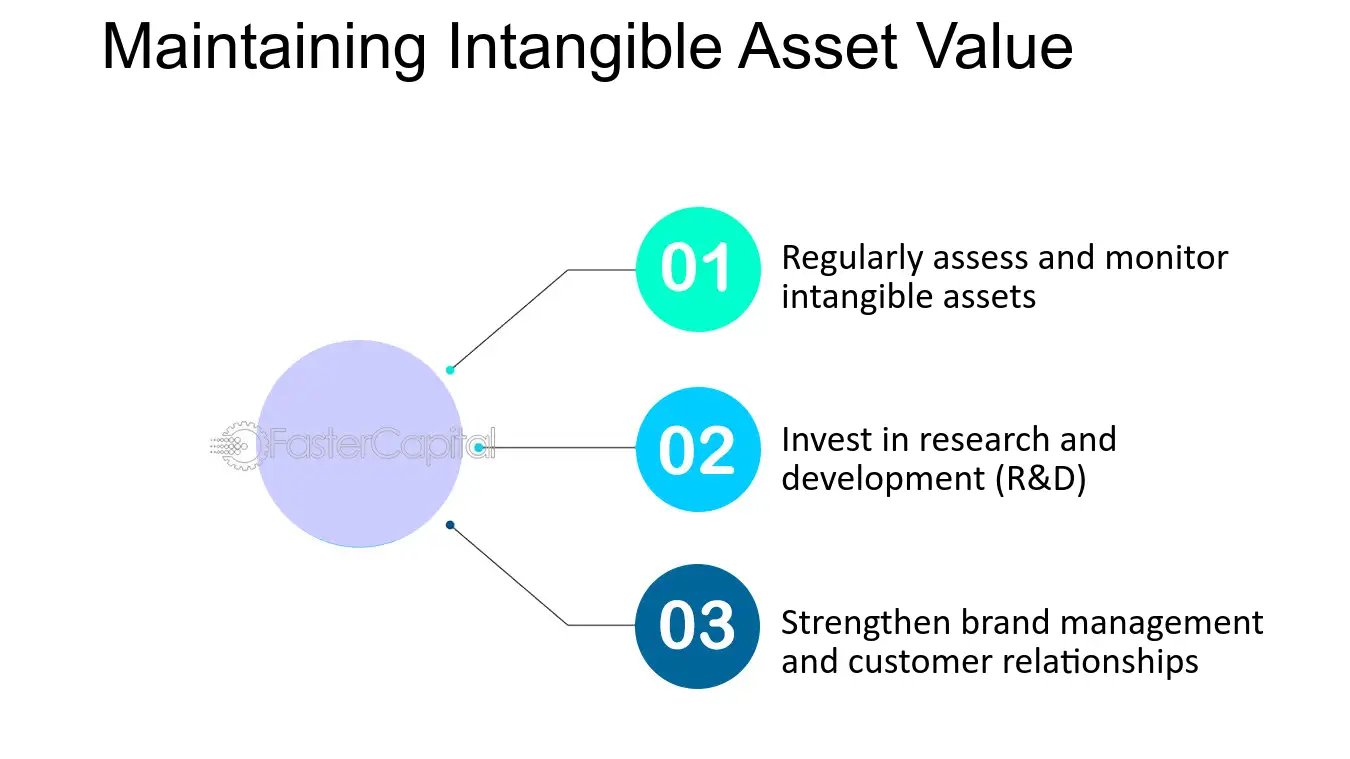
Maintaining Intangible Asset Value - Navigating Goodwill Impairment: The Impact of Intangible Assets
25. The Role of R&D in Intangible Asset Creation
In today's fast-paced and competitive business environment, companies need to constantly innovate and create new products to stay ahead of the competition. Research and Development (R&D) plays a crucial role in this process, as it provides the necessary resources and expertise to create intangible assets that can drive growth and profitability. In this blog section, we will explore the role of R&D in intangible asset creation and provide insights from different perspectives.
1. R&D as a driver of innovation
R&D is often seen as the primary driver of innovation, as it allows companies to develop new technologies, products, and processes that can create value for customers. By investing in R&D, companies can stay ahead of the competition and differentiate themselves in the market. For example, Apple's investment in R&D has helped the company develop innovative products such as the iPhone and iPad, which have become major sources of revenue.
2. R&D as a means of creating intellectual property
R&D can also help companies create intellectual property (IP) such as patents, trademarks, and copyrights, which can provide a competitive advantage and protect the company's innovations from being copied by competitors. By securing IP rights, companies can create barriers to entry and establish themselves as leaders in their respective markets. For example, pharmaceutical companies invest heavily in R&D to develop new drugs and secure patents that can provide them with exclusive rights to sell those drugs.
3. R&D as a source of intangible assets
Intangible assets such as brand value, customer relationships, and employee expertise can be created through R&D. By investing in R&D, companies can develop new products and services that can enhance their brand value and reputation. Additionally, R&D can help companies build strong relationships with customers by providing them with innovative solutions that meet their needs. Finally, R&D can help companies develop the expertise of their employees, which can become a valuable intangible asset.
4. The importance of balancing R&D investments with other business priorities
While R&D is important for creating intangible assets, it is also important for companies to balance their R&D investments with other business priorities such as cost control and profitability. Companies need to make strategic decisions about where to invest their resources and ensure that their R&D investments are aligned with their overall business strategy. For example, a company may choose to invest in R&D in areas where it has a competitive advantage or where it sees the greatest potential for growth.
5. The role of collaboration in R&D
Collaboration can play a key role in R&D, as it allows companies to leverage the expertise of other organizations and share the risks and costs of innovation. For example, pharmaceutical companies often collaborate with academic institutions and other companies to develop new drugs. Additionally, open innovation platforms such as InnoCentive allow companies to crowdsource ideas and solutions from a global network of experts.
R&D plays a critical role in creating intangible assets that can drive growth and profitability for companies. By investing in R&D, companies can drive innovation, create IP, and develop intangible assets such as brand value and customer relationships. However, it is important for companies to balance their R&D investments with other business priorities and consider collaboration as a means of leveraging expertise and sharing risks and costs.
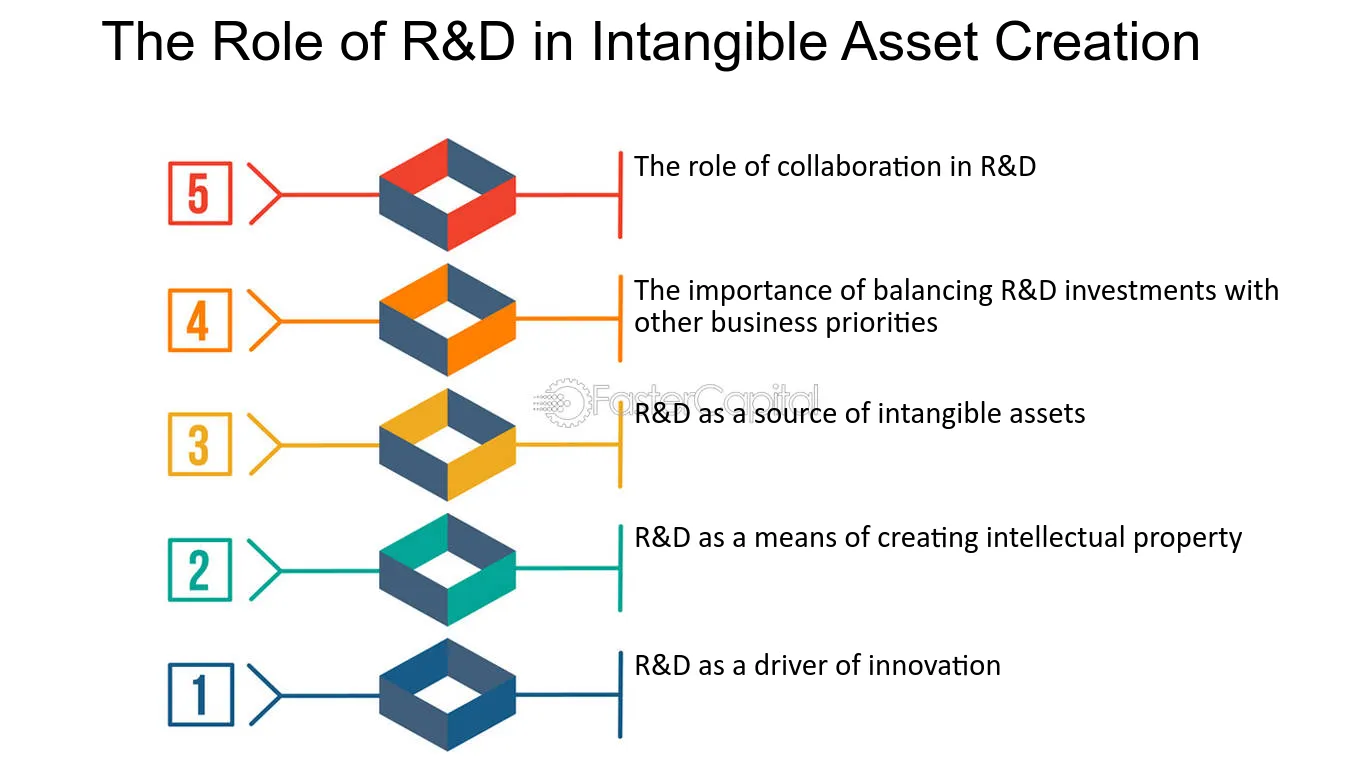
The Role of R&D in Intangible Asset Creation - R D Investments: Fueling Intangible Asset Creation
26. The Benefits of Intangible Asset Creation for Businesses
Intangible assets are a crucial part of any business. They represent the non-physical assets that can help businesses generate revenue and create value. Intangible assets include things like patents, trademarks, copyrights, and trade secrets. The creation of intangible assets is an important part of any R&D investment strategy, as it can help businesses stay competitive and generate profits in the long run. In this blog, we will discuss the benefits of intangible asset creation for businesses.
1. Competitive Advantage: One of the most significant benefits of intangible asset creation is the competitive advantage it can provide. When businesses create unique patents, trademarks, or other intangible assets, they can protect their products or services from competitors. This can help businesses maintain their market share and generate revenue over the long term. For example, Coca-Cola's trademark is a valuable intangible asset that has helped the company maintain its position as one of the world's leading beverage companies.
2. Increased Revenue: Intangible assets can also help businesses generate revenue. When businesses create patents or trademarks, they can license these assets to other companies in exchange for royalties. This can be a lucrative source of income for businesses, as they can collect revenue without having to invest in additional resources. For example, IBM has generated billions in revenue by licensing its patents to other companies.
3. Improved Brand Value: Intangible assets can also help businesses improve their brand value. When businesses create trademarks or other intangible assets, they can create a unique identity that sets them apart from competitors. This can help businesses build a loyal customer base and generate repeat business over the long term. For example, Apple's brand value is worth over $300 billion, largely due to the company's innovative product designs and trademarks.
4. Increased Innovation: Intangible asset creation can also lead to increased innovation. When businesses invest in R&D to create new patents or trade secrets, they can develop new products or services that can help them stay ahead of competitors. This can lead to increased revenue and market share over the long term. For example, Google's investment in R&D has led to the creation of new products like Google Maps and Google Drive, which have helped the company maintain its position as one of the world's leading tech companies.
The creation of intangible assets is an important part of any R&D investment strategy. Intangible assets can help businesses stay competitive, generate revenue, improve brand value, and increase innovation. By investing in intangible asset creation, businesses can create long-term value for their shareholders and stakeholders.
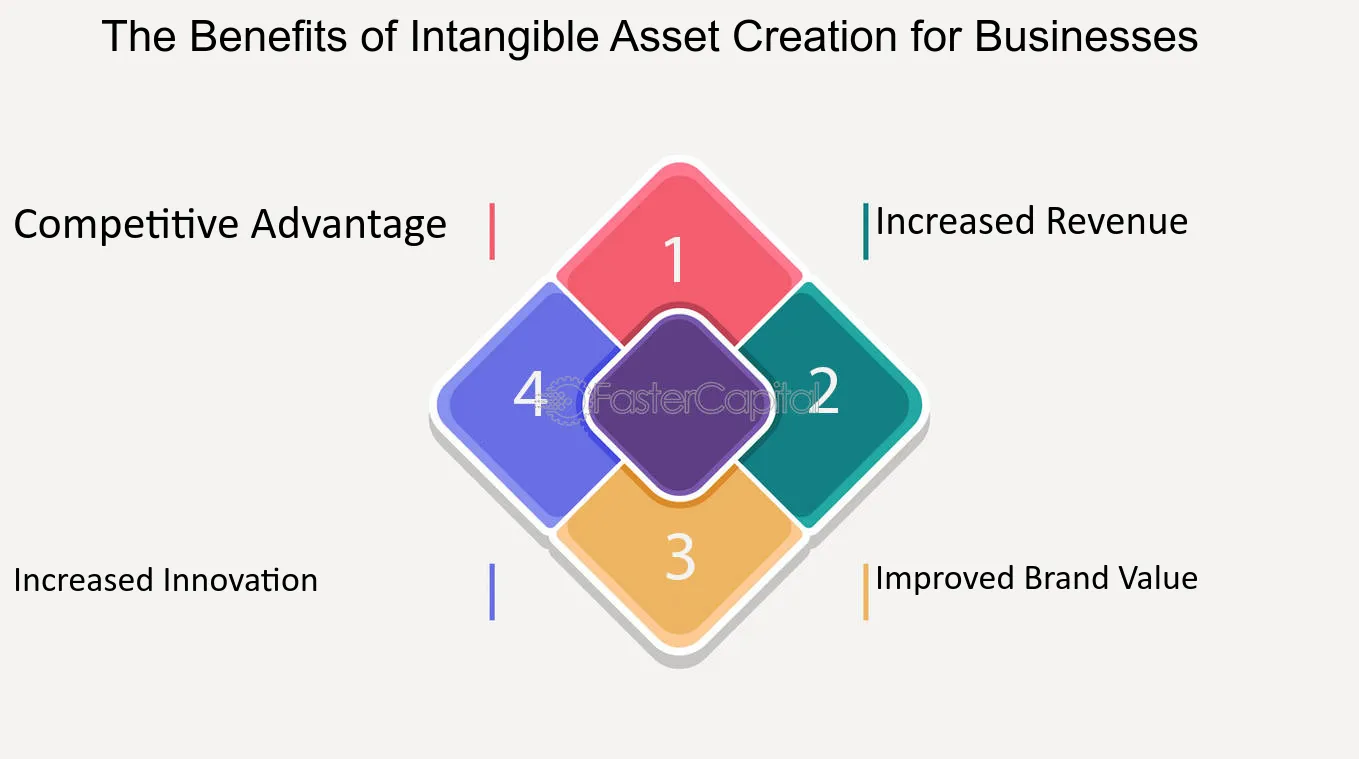
The Benefits of Intangible Asset Creation for Businesses - R D Investments: Fueling Intangible Asset Creation
27. Strategies for Maximizing R&D Investments for Intangible Asset Creation
When it comes to maximizing R&D investments for intangible asset creation, there are several strategies that can be employed by organizations. These strategies take into account the unique nature of intangible assets and the challenges associated with their creation. From leveraging open innovation to investing in human capital, the following strategies can help organizations get the most out of their R&D investments.
1. Invest in human capital: One of the most important strategies for maximizing R&D investments is to invest in human capital. This means hiring and retaining top talent in the fields of science, technology, engineering, and mathematics (STEM). By doing so, organizations can ensure that they have the expertise necessary to create and develop intangible assets. Additionally, investing in training and development programs can help employees stay up-to-date with the latest trends and technologies, further enhancing their ability to create valuable intangible assets.
2. Leverage open innovation: Another strategy for maximizing R&D investments is to leverage open innovation. This involves collaborating with external partners, such as universities, research institutes, and other organizations, to share knowledge and resources. By doing so, organizations can access a wider pool of expertise and resources, which can lead to the creation of more valuable intangible assets. Additionally, open innovation can help organizations reduce costs and shorten development timelines, as they can leverage existing knowledge and expertise.
3. Embrace agile development: Agile development is a methodology that emphasizes collaboration, flexibility, and rapid iteration. By embracing agile development, organizations can more quickly develop and refine intangible assets, reducing the time and cost associated with R&D. Additionally, agile development can help organizations better respond to changing market conditions and customer needs, ensuring that their intangible assets remain relevant and valuable over time.
4. Focus on intellectual property protection: Intellectual property (IP) protection is critical for maximizing the value of intangible assets. By securing patents, trademarks, and copyrights, organizations can prevent others from using their intangible assets without permission, ensuring that they can monetize their investments. Additionally, IP protection can help organizations attract investors and partners, as it demonstrates the value of their intangible assets.
5. Prioritize strategic alignment: Finally, organizations must prioritize strategic alignment when developing intangible assets. This means ensuring that their R&D investments are aligned with their overall business strategy and goals. By doing so, organizations can ensure that their intangible assets are relevant and valuable to their customers and stakeholders. Additionally, strategic alignment can help organizations prioritize their R&D investments, ensuring that they are focusing on the most important and valuable intangible assets.
Maximizing R&D investments for intangible asset creation requires a multi-faceted approach that takes into account the unique nature of intangible assets. By investing in human capital, leveraging open innovation, embracing agile development, focusing on IP protection, and prioritizing strategic alignment, organizations can get the most out of their R&D investments and create valuable intangible assets that drive business success.
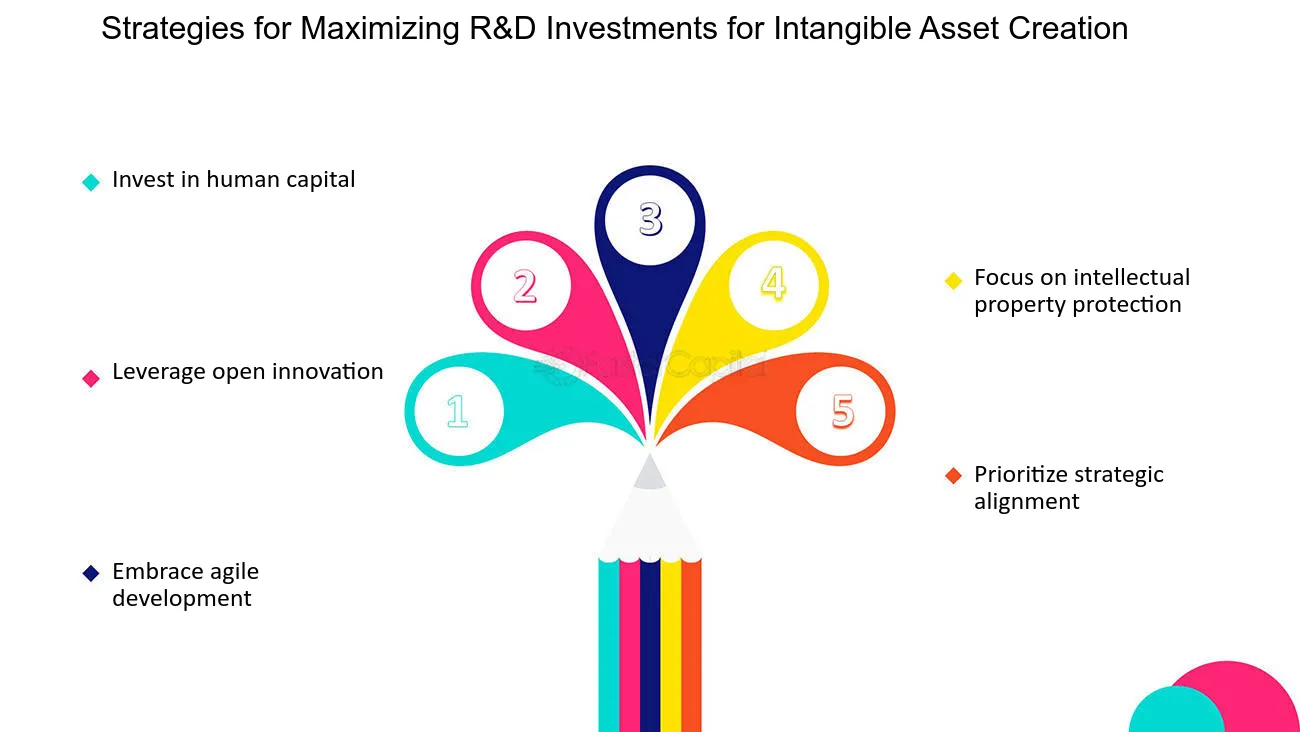
Strategies for Maximizing R&D Investments for Intangible Asset Creation - R D Investments: Fueling Intangible Asset Creation
28. Successful R&D Investments and Intangible Asset Creation
One of the most challenging aspects of R&D investments is determining whether they will create intangible assets that are valuable to the company. Intangible assets such as patents, trademarks, and trade secrets are crucial for companies to maintain their competitive advantage in the market. In this section, we will examine case studies of successful R&D investments and intangible asset creation, providing insights into what makes them successful.
1. Collaboration with universities and research institutions
One way to ensure successful R&D investments is to collaborate with universities and research institutions. These partnerships provide access to cutting-edge research and development capabilities that may not be available in-house. For example, Pfizer's collaboration with the University of California, San Francisco, led to the development of a new drug for treating breast cancer. This collaboration allowed Pfizer to leverage the expertise of the university's researchers and develop a drug that was not only effective but also had a strong patent portfolio.
2. Focusing on innovation in existing products
Another way to create successful R&D investments is to focus on innovation in existing products. This approach allows companies to build on their existing market position and create new intangible assets that are closely related to their core business. For example, Apple's introduction of the iPhone in 2007 was a significant innovation in the smartphone market. The iPhone's design and features were quickly copied by competitors, but Apple's patents and trademarks protected the company's intellectual property.
3. Investing in emerging technologies
Investing in emerging technologies is another way to create successful R&D investments. Emerging technologies, such as artificial intelligence and blockchain, have the potential to disrupt entire industries. Companies that invest in these technologies early can create significant intangible assets that provide a competitive advantage. For example, IBM's investment in blockchain technology has led to the creation of a strong patent portfolio that is valuable in the financial services industry.
4. balancing short-term and long-term goals
One of the challenges of R&D investments is balancing short-term and long-term goals. Companies must continue to innovate and create intangible assets that provide a competitive advantage in the short term while investing in R&D projects that may not provide a return for years. For example, Tesla's investment in electric vehicle technology was a long-term bet that has paid off in the short term. Tesla's patents and trademarks in electric vehicle technology have allowed the company to maintain a dominant position in the market.
5. Leveraging global talent
Finally, successful R&D investments require leveraging global talent. With the rise of remote work and global collaboration tools, companies can access talent from all over the world. This approach allows companies to create intangible assets that are not limited by geographic boundaries. For example, Google's acquisition of DeepMind, a UK-based artificial intelligence company, allowed the company to access top talent in the field and create a strong patent portfolio in AI.
Successful R&D investments require a combination of approaches, including collaboration with universities and research institutions, focusing on innovation in existing products, investing in emerging technologies, balancing short-term and long-term goals, and leveraging global talent. Companies that can effectively create intangible assets through R&D investments will be better positioned to maintain their competitive advantage in the market.

Successful R&D Investments and Intangible Asset Creation - R D Investments: Fueling Intangible Asset Creation
29. Future Trends in R&D Investments and Intangible Asset Creation
The future of R&D investments and intangible asset creation is constantly evolving as technology advances and markets shift. In this section, we will explore some of the current trends and future predictions for R&D investments and intangible asset creation.
1. Increased focus on sustainability: As companies become more aware of their environmental impact, there is a growing trend towards investing in sustainable R&D. This includes developing products and processes that are more environmentally friendly, as well as finding ways to reduce waste and energy consumption. For example, companies like Tesla are investing heavily in developing electric cars and renewable energy technologies.
2. Growing importance of data analytics: With the rise of big data, companies are increasingly investing in R&D to develop advanced data analytics tools. These tools can help companies better understand customer behavior, optimize supply chains, and improve product design. For example, Amazon uses sophisticated algorithms to analyze customer data and make personalized product recommendations.
3. Shift towards open innovation: In the past, R&D was often conducted in-house, with companies investing heavily in their own research teams and facilities. However, there is a growing trend towards open innovation, where companies collaborate with external partners to develop new technologies and products. This approach can help companies access a wider range of expertise and resources, and can lead to faster innovation cycles. For example, Apple collaborates with external suppliers to develop new components for their products.
4. Increased investment in AI and automation: As AI and automation technologies continue to advance, companies are investing heavily in R&D to develop new applications. This includes developing algorithms that can automate routine tasks, as well as developing AI-powered products and services. For example, Google is investing in developing AI-powered chatbots that can provide customer service support.
The future of R&D investments and intangible asset creation is likely to be shaped by a range of factors, including sustainability, data analytics, open innovation, and AI and automation. Companies that are able to stay ahead of these trends and invest strategically in R&D are likely to be well positioned for success in the years ahead.
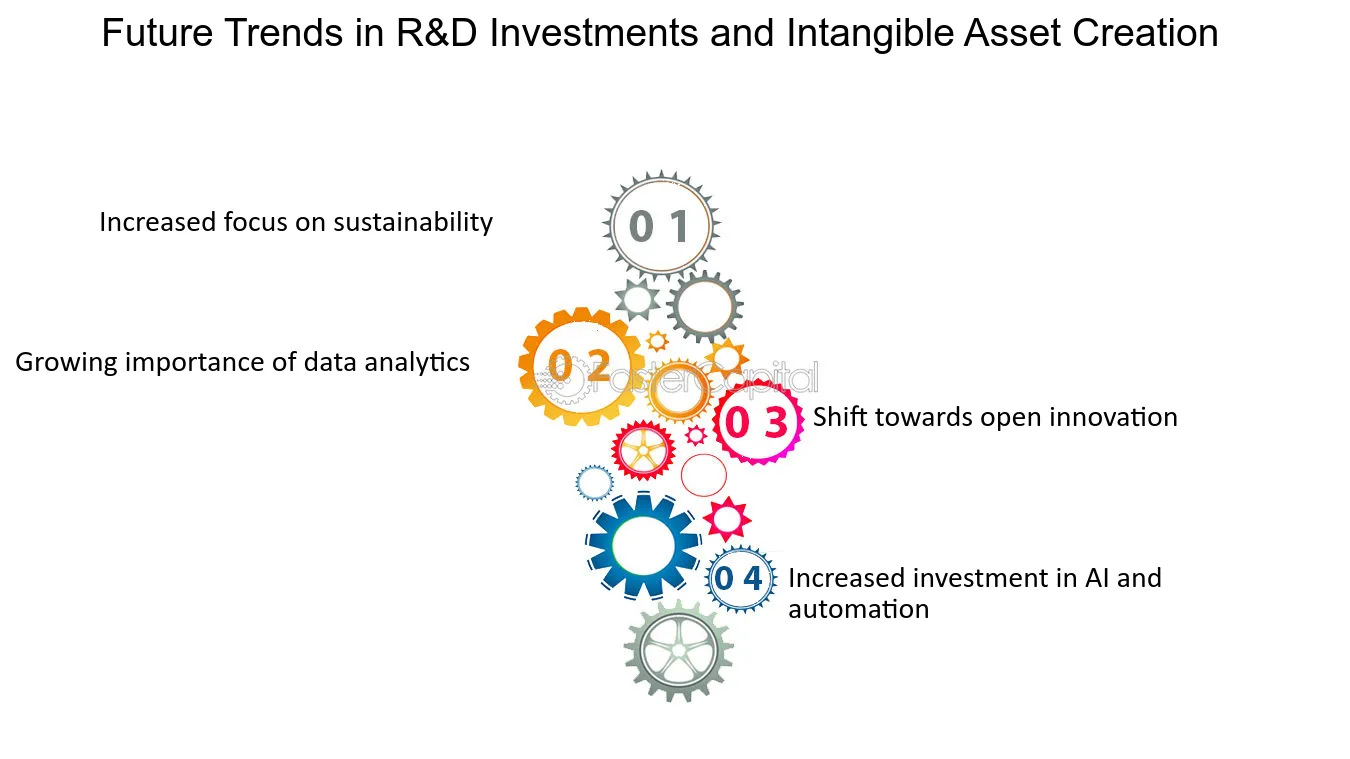
Future Trends in R&D Investments and Intangible Asset Creation - R D Investments: Fueling Intangible Asset Creation
30. Software as an Intangible Asset
Software is an intangible asset that holds immense value for businesses operating in the digital age. It is a product of human intelligence and creativity, and it is an essential tool for organizations that aim to increase efficiency and productivity. Software has become a crucial component of business operations, and it is now considered a valuable asset that can be leveraged for competitive advantage.
1. Defining Software as an Intangible Asset
An intangible asset is a non-physical asset that has no intrinsic value but is valuable because of the rights and privileges it confers upon the owner. Software is an intangible asset because it is a product of human creativity and intellect, and it has no physical form. However, it is valuable because it can be used to perform specific functions and solve problems. Software can also be protected by intellectual property laws, such as patents, copyrights, and trademarks, which can confer exclusive rights to the owner and prevent others from using or copying the software.
2. The Value of Software as an Intangible Asset
Software is a valuable asset for businesses because it can provide a competitive advantage. It can help organizations to automate processes, reduce costs, increase efficiency, and improve the quality of their products and services. Software can also be used to develop new products and services, which can create new revenue streams and increase profitability. Moreover, software can be licensed or sold to other businesses, which can generate additional revenue and increase the value of the asset.
3. Factors that Affect the Value of Software as an Intangible Asset
Several factors can affect the value of software as an intangible asset. These factors include the complexity of the software, the market demand for the software, the level of competition in the market, the quality of the software, and the ability of the software to meet the needs of the users. The value of the software can also be affected by the level of protection provided by intellectual property laws, such as patents, copyrights, and trademarks.
4. Options for Protecting Software as an Intangible Asset
There are several options for protecting software as an intangible asset. The most common options include patents, copyrights, and trademarks. Patents can be used to protect the functionality of the software, while copyrights can be used to protect the source code and other creative elements of the software. Trademarks can be used to protect the brand name and logo associated with the software. Each of these options has its advantages and disadvantages, and the best option will depend on the specific needs and goals of the business.
5. Conclusion
Software is an intangible asset that holds immense value for businesses operating in the digital age. It is a product of human creativity and intellect, and it can provide a competitive advantage for organizations that use it effectively. Protecting software as an intangible asset can be challenging, but there are several options available to businesses, including patents, copyrights, and trademarks. The best option will depend on the specific needs and goals of the business.
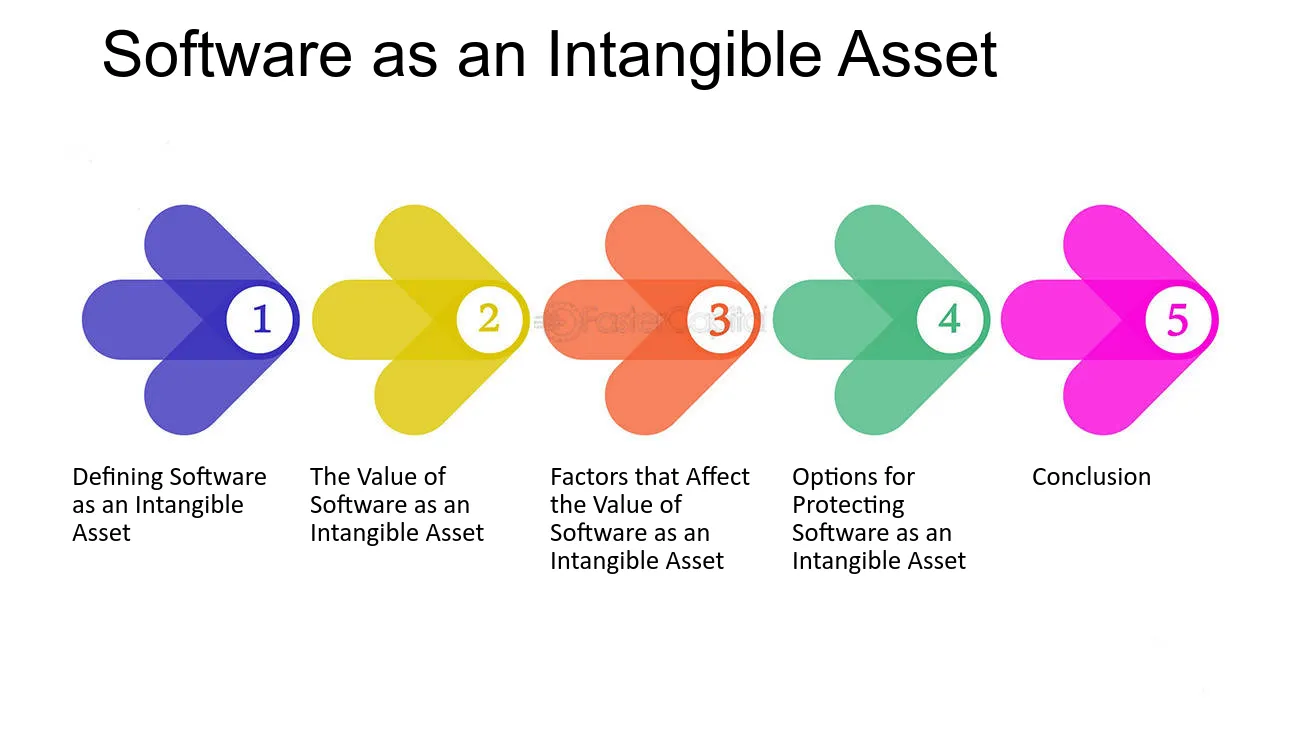
Software as an Intangible Asset - Software: The Digital Frontier: Intangible Assets in Software Development
31. Understanding the Importance of Intangible Asset Valuation in Acquisition Adjustments
1. Intangible assets play a crucial role in today's business landscape, often serving as the driving force behind a company's success. When it comes to mergers and acquisitions, understanding the value of these intangible assets becomes even more important. In this blog section, we will delve into the significance of intangible asset valuation in acquisition adjustments and explore why it is a critical aspect of the due diligence process.
2. valuing intangible assets accurately is essential for both the buyer and the seller in an acquisition. For the buyer, it helps in determining the fair price to be paid for the target company, ensuring that they are not overpaying or undervaluing the intangible assets. On the other hand, for the seller, it allows them to showcase the true value of their intangible assets, potentially increasing the overall deal value.
3. One example of the importance of intangible asset valuation is the acquisition of a technology startup. The startup may have developed innovative software or patented technology, which could be its most valuable assets. In such cases, accurately valuing these intangible assets becomes crucial for the acquirer to assess the startup's true worth and potential future earnings.
4. Tips for conducting intangible asset valuation in acquisition adjustments:
A. Engage experienced professionals: Intangible asset valuation is a specialized field that requires expertise. Engaging professionals with experience in valuing intangible assets can help ensure a thorough evaluation and accurate assessment.
B. Consider industry-specific factors: Different industries may have unique intangible assets that contribute to the company's value. understanding these industry-specific factors is essential for conducting a comprehensive valuation.
C. Assess the competitive landscape: Evaluating how the target company's intangible assets compare to its competitors can provide valuable insights into their market position and potential future growth.
5. Case study: The acquisition of Instagram by Facebook serves as an intriguing case study on intangible asset valuation. When Facebook acquired Instagram for $1 billion in 2012, many questioned the valuation of a company with no significant tangible assets. However, Facebook recognized the value of Instagram's user base, brand reputation, and proprietary algorithms, which ultimately justified the substantial acquisition price.
6. In conclusion, intangible asset valuation plays a pivotal role in acquisition adjustments. It enables both buyers and sellers to make informed decisions, ensuring a fair deal and maximizing value. By engaging professionals, considering industry-specific factors, and conducting thorough evaluations, companies can navigate the complex landscape of intangible asset valuation successfully.
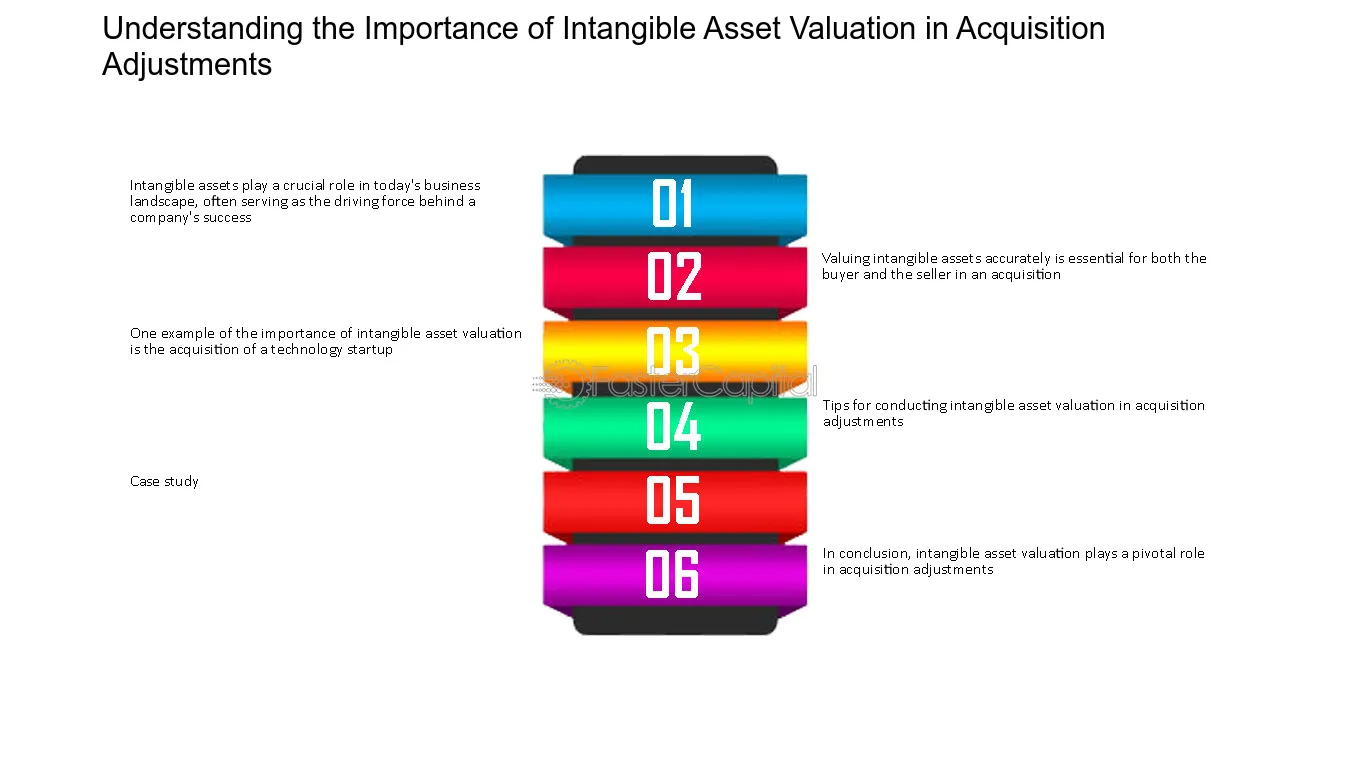
Understanding the Importance of Intangible Asset Valuation in Acquisition Adjustments - Unveiling Acquisition Adjustments: Untangling Intangible Asset Valuation
32. Methods and Approaches for Intangible Asset Valuation
1. Identifying and Understanding Intangible Assets
Intangible assets play a crucial role in today's business landscape, often contributing significantly to a company's value and competitive advantage. However, valuing these assets can be a complex and challenging task. To accurately assess their worth, it is essential to employ appropriate methods and approaches that take into account the unique nature of intangible assets.
2. Cost Approach
One commonly used method for valuing intangible assets is the cost approach. This approach involves determining the cost to create or replace the asset, taking into consideration factors such as development costs, research expenses, and legal fees. For example, if a company has spent $1 million in research and development for a patented technology, the cost approach would value the intangible asset at $1 million.
3. Market Approach
The market approach relies on comparing the value of similar intangible assets that have been recently sold or licensed. By examining transactions in the same industry or market, analysts can estimate the value of a specific intangible asset based on market trends. For instance, if a trademark with similar characteristics to the one being valued was recently sold for $500,000, the market approach would suggest a similar value for the asset under consideration.
4. Income Approach
The income approach focuses on the future economic benefits that an intangible asset is expected to generate. This method calculates the asset's value by estimating the present value of anticipated cash flows over its useful life. For example, if a software company expects its proprietary software to generate $500,000 in annual cash flows for the next five years, discounted at an appropriate rate, the income approach would value the intangible asset based on the net present value of these cash flows.
5. Tips for Effective Intangible Asset Valuation
- Engage a team of professionals: Valuing intangible assets requires expertise in various fields, including finance, accounting, and intellectual property. Assemble a team of professionals with diverse backgrounds to ensure a comprehensive and accurate valuation.
- Consider market conditions and industry trends: The value of intangible assets can be influenced by market conditions and industry trends. stay informed about the latest developments in your sector to make more accurate assessments.
- Leverage case studies and benchmarks: Case studies and benchmarks can provide valuable insights into how similar intangible assets have been valued in the past. Analyze these examples to gain a better understanding of the factors that affect valuation.
6. Case Study: Valuing a Brand
Consider a case where a company wants to value its brand, a significant intangible asset. The cost approach may involve evaluating the expenses incurred in developing and promoting the brand, such as advertising and marketing costs. The market approach could involve comparing the brand's value to similar brands that have been sold or licensed recently. The income approach would consider the brand's future earnings potential based on factors like brand loyalty and market demand.
Valuing intangible assets requires a thoughtful and systematic approach. The cost, market, and income approaches are commonly used methods, each providing unique insights into the value of intangible assets. By engaging professionals, considering market conditions, and leveraging case studies, companies can improve the accuracy of their intangible asset valuation, leading to more informed business decisions.
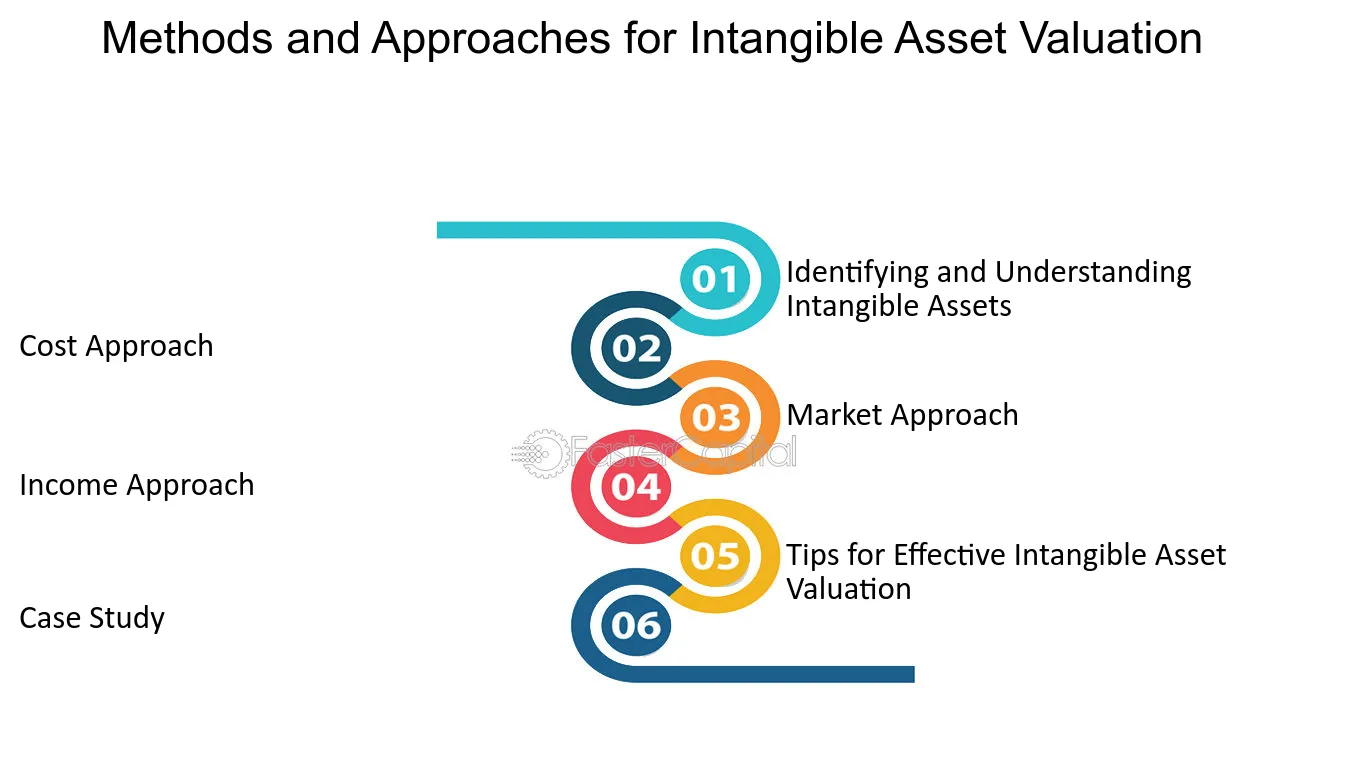
Methods and Approaches for Intangible Asset Valuation - Unveiling Acquisition Adjustments: Untangling Intangible Asset Valuation
33. Key Factors Influencing Intangible Asset Valuation in Acquisition Adjustments
1. Identification and Classification of Intangible Assets: The first key factor influencing intangible asset valuation in acquisition adjustments is the accurate identification and classification of these assets. Intangible assets can include trademarks, patents, copyrights, customer relationships, and proprietary technology, among others. Properly identifying and classifying these assets is crucial as it determines their value and the appropriate valuation methods to be employed. For example, a company acquiring a software development firm must identify and classify the proprietary software as an intangible asset to determine its value.
2. Determination of Useful Life: The useful life of an intangible asset is another important factor that affects its valuation. The useful life represents the period over which the asset is expected to contribute to the acquiring company's future cash flows. Determining the useful life requires a thorough analysis of factors such as technological obsolescence, legal or contractual limitations, and market conditions. For instance, a company acquiring a patent for a new technology must assess the expected lifespan of the technology and adjust the valuation accordingly.
3. Market Comparables and Benchmarking: Market comparables and benchmarking play a significant role in intangible asset valuation. Comparing the asset being valued to similar assets that have been recently sold or licensed in the market helps establish a fair value. For example, if a company is acquiring a brand name, it may examine recent acquisitions of similar brands to determine a reasonable valuation range.
4. Financial projections and Cash flow Analysis: Accurate financial projections and cash flow analysis are crucial for valuing intangible assets in acquisition adjustments. These projections should reflect the expected future benefits derived from the intangible asset. For instance, a company acquiring a customer relationship database must analyze the projected revenue and cost savings resulting from the enhanced customer base.
5. Expertise and Experience: Engaging professionals with expertise and experience in intangible asset valuation is highly recommended. These experts possess the knowledge and skills necessary to navigate the complexities of intangible asset valuation and ensure accurate and reliable results. They can provide valuable insights, especially in determining appropriate valuation methods and assumptions. Case studies have shown that relying on expert opinions can significantly impact the final valuation outcome.
6. Legal and Regulatory Considerations: Legal and regulatory considerations can also influence intangible asset valuation in acquisition adjustments. For instance, the presence of non-compete agreements or intellectual property rights can affect the value of an intangible asset. It is crucial to carefully assess the legal and regulatory environment surrounding the asset to ensure accurate valuation.
Several key factors influence intangible asset valuation in acquisition adjustments. Accurate identification and classification, determination of useful life, market comparables, financial projections, expertise, and legal considerations all play crucial roles. Understanding and considering these factors can help ensure a fair and reliable valuation of intangible assets, ultimately leading to informed decision-making in acquisition adjustments.
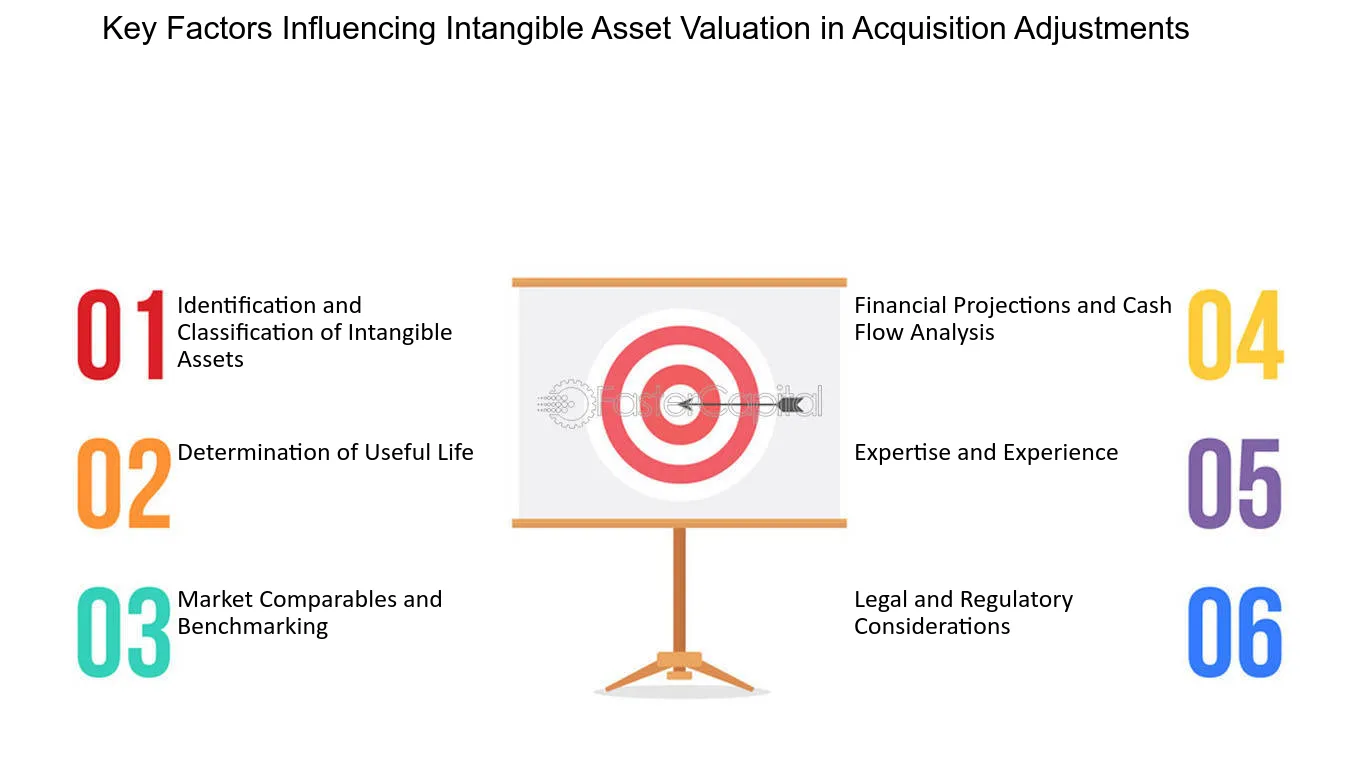
Key Factors Influencing Intangible Asset Valuation in Acquisition Adjustments - Unveiling Acquisition Adjustments: Untangling Intangible Asset Valuation
34. Real-Life Examples of Intangible Asset Valuation in Acquisition Adjustments
1. Introduction
Intangible assets play a crucial role in the valuation of companies during acquisitions. These assets, which are not physical in nature, can include patents, trademarks, copyrights, customer relationships, and brand value, among others. Accurately valuing intangible assets is essential for determining the fair value of a company and making informed acquisition decisions. In this section, we will delve into real-life case studies that illustrate the complexities and challenges of intangible asset valuation in acquisition adjustments.
2. Case Study 1: Valuing Intellectual Property
Company A, a technology firm, acquired Company B, which held several patents for innovative software solutions. The valuation of these patents was critical in determining the fair value of Company B. The acquirer engaged a team of experts to assess the strength, market potential, and remaining useful life of the patents. The team also considered the competitive landscape and the expected future cash flows generated by the patented software. Through a combination of income, market, and cost approaches, the experts determined a fair value for the intellectual property, which was subsequently adjusted in the acquisition.
Tip: When valuing intellectual property, it is important to consider not only the legal ownership but also the market demand, potential infringement risks, and the asset's remaining useful life.
3. Case Study 2: Evaluating Customer Relationships
In another acquisition scenario, Company X acquired Company Y, an established retail brand with a loyal customer base. Understanding the value of Company Y's customer relationships was crucial for determining the acquisition price. Company X conducted extensive market research, analyzing customer retention rates, purchasing patterns, and customer satisfaction levels. By applying a discounted cash flow analysis, they estimated the future cash flows attributable to the customer relationships. These findings were then used to adjust the acquisition price, reflecting the intangible value of Company Y's customer relationships.
Tip: To evaluate customer relationships, it is important to consider factors such as customer loyalty, brand reputation, customer acquisition costs, and the potential for future growth.
4. Case Study 3: Assessing Brand Value
Company Z, a multinational conglomerate, acquired a small but highly recognized luxury brand. The challenge in this acquisition was valuing the brand itself, which held significant intangible value. Company Z engaged a brand valuation specialist who assessed factors such as brand awareness, brand equity, market positioning, and brand loyalty. By comparing the acquired brand's financial performance with similar luxury brands, the specialist determined a fair value for the brand. This valuation was then incorporated into the overall acquisition adjustment.
Tip: When assessing brand value, it is crucial to consider both financial and non-financial factors, including brand reputation, market presence, consumer perception, and the potential for future brand extensions.
5. Conclusion
Intangible asset valuation in acquisition adjustments presents a unique set of challenges that require expertise and careful analysis. The case studies discussed above demonstrate the importance of considering various factors, such as intellectual property, customer relationships, and brand value, when determining the fair value of intangible assets. By utilizing a combination of valuation approaches and engaging specialists in the field, companies can make informed acquisition decisions and accurately reflect the intangible value in their financial statements.
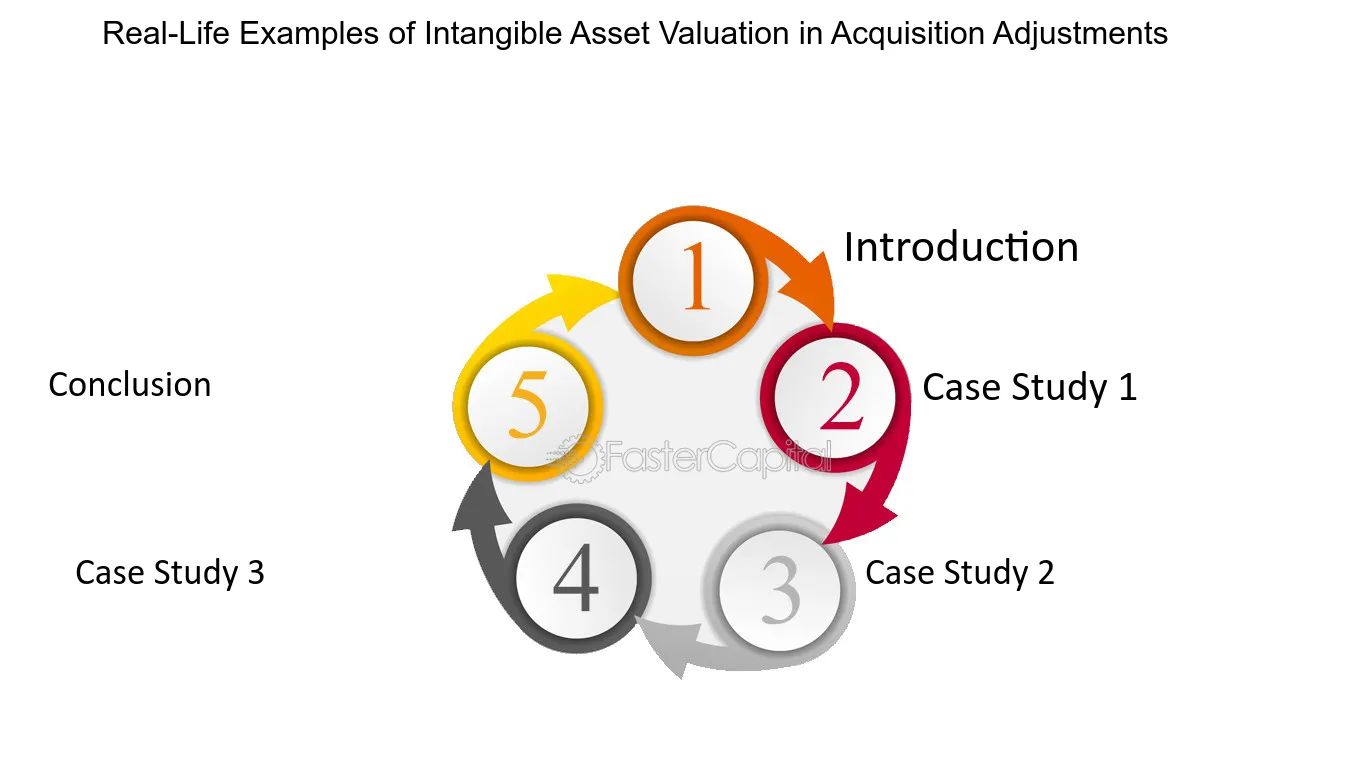
Real Life Examples of Intangible Asset Valuation in Acquisition Adjustments - Unveiling Acquisition Adjustments: Untangling Intangible Asset Valuation
35. Best Practices for Ensuring Accurate Intangible Asset Valuation
1. Conduct thorough due diligence: Before valuing intangible assets, it is crucial to conduct comprehensive due diligence to gather all relevant information. This includes understanding the nature of the assets, their legal protection, market demand, and competitive landscape. For example, when valuing a software patent, it is important to assess its uniqueness and the potential market demand for such technology.
2. Engage qualified professionals: Valuing intangible assets can be complex, requiring specialized knowledge and expertise. Engaging qualified professionals such as appraisers, intellectual property attorneys, or valuation experts can help ensure accurate valuations. These professionals can provide insights into industry-specific factors and best practices in valuation methodologies. For instance, an experienced appraiser can use different valuation approaches, including the income, market, or cost approach, to determine the fair value of intangible assets.
3. Consider the income approach: The income approach is commonly used to value intangible assets based on their expected future economic benefits. This approach estimates the present value of projected cash flows generated by the assets. For instance, when valuing a customer database, one could estimate the future revenue streams derived from customer retention and new customer acquisition.
4. Evaluate market comparables: Looking at market comparables can provide valuable insights into the value of intangible assets. Comparable transactions or licensing agreements involving similar assets can serve as benchmarks for valuation. For example, if a company is valuing its brand name, it may analyze recent sales or licensing deals of similar brands in the same industry to determine a fair value.
5. Understand legal and regulatory considerations: Intangible asset valuation should also take into account legal and regulatory considerations. intellectual property protection, licensing agreements, and any pending litigation can significantly impact the value of intangible assets. For instance, a patent involved in ongoing litigation may have a lower value due to the associated legal risks.
6. Regularly reassess valuations: intangible assets are not static and can change in value over time. It is important to regularly reassess the valuations to account for changes in market conditions, technological advancements, or shifts in industry trends. By regularly reviewing and updating valuations, companies can ensure their financial statements reflect the most accurate value of their intangible assets.
Case Study: XYZ Corporation, a technology company, recently acquired a start-up with a unique software algorithm. To accurately value this intangible asset, XYZ engaged an independent valuation expert who analyzed the market demand for such technology, assessed the uniqueness of the algorithm, and projected its future cash flows. This comprehensive approach resulted in a fair valuation that reflected the true value of the asset, enabling XYZ to make informed business decisions.
Accurate intangible asset valuation is essential for companies to make informed financial decisions and properly reflect the value of their assets. By following best practices such as conducting thorough due diligence, engaging qualified professionals, considering the income approach, evaluating market comparables, understanding legal and regulatory considerations, and regularly reassessing valuations, companies can ensure accurate and reliable valuations of their intangible assets.
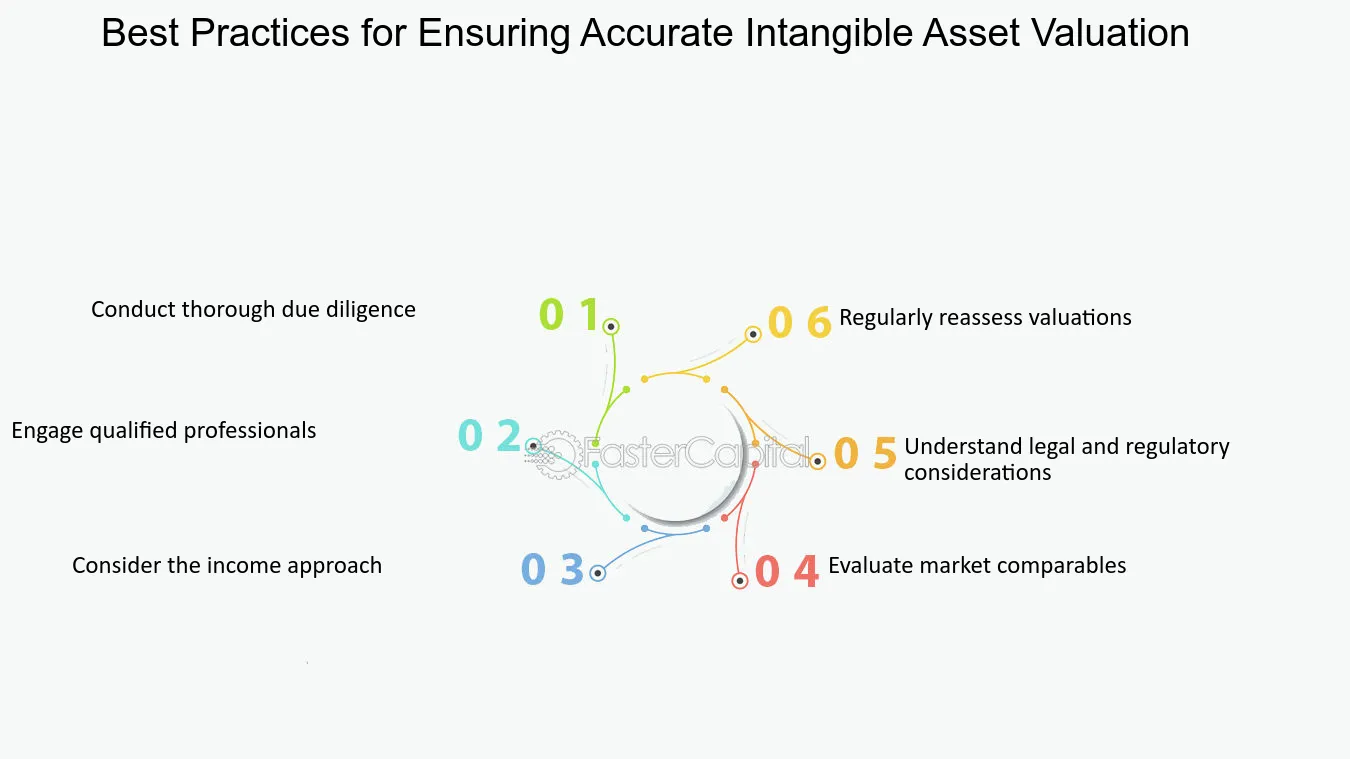
Best Practices for Ensuring Accurate Intangible Asset Valuation - Unveiling Acquisition Adjustments: Untangling Intangible Asset Valuation
36. The Role of Professional Valuators in Intangible Asset Valuation
1. Understanding the Importance of Professional Valuators in Intangible Asset Valuation
When it comes to valuing intangible assets, businesses often face significant challenges. Unlike tangible assets such as buildings or equipment, intangible assets lack physical substance, making their valuation a complex and nuanced process. In order to accurately determine the value of intangible assets, professional valuators play a crucial role. Their expertise and experience enable them to navigate the intricacies of intangible asset valuation, ensuring that businesses can make informed decisions in various scenarios, such as mergers and acquisitions, financial reporting, or intellectual property management.
2. The Expertise of Professional Valuators
Professional valuators possess specialized knowledge and skills that are essential for assessing and valuing intangible assets. They are well-versed in the various methodologies and approaches used in intangible asset valuation, including the cost, market, and income approaches. By applying these methodologies, valuators can determine the fair value of intangible assets based on factors such as market demand, intellectual property rights, brand recognition, customer relationships, and technology advancements.
3. Tips for Maximizing the Role of Professional Valuators
To ensure the accuracy and reliability of intangible asset valuation, businesses can follow these tips when working with professional valuators:
- Clearly define the purpose of the valuation: Providing a clear understanding of why the valuation is needed helps valuators tailor their approach to meet specific objectives. Whether it is for mergers and acquisitions, financial reporting, or litigation purposes, defining the purpose upfront enables valuators to focus on the relevant factors and provide a comprehensive valuation.
- Collaborate with internal stakeholders: Internal collaboration is key to a successful valuation process. By involving key personnel, such as finance, legal, and marketing teams, businesses can provide valuators with crucial insights about the intangible assets being valued. This collaboration ensures that all relevant information is considered and enhances the accuracy of the valuation.
4. Case Studies: Real-World Examples
To illustrate the significance of professional valuators in intangible asset valuation, let's consider a few real-world case studies:
- Company A, a technology startup, is seeking external funding to expand its operations. The investors require a valuation of the company's patented technology. A professional valuator assesses the technology's uniqueness, market potential, and competitive advantage, resulting in a fair value that helps the company secure the necessary funding.
- Company B, a well-established brand, is planning to acquire a competitor. To determine the value of the competitor's brand and customer relationships, professional valuators conduct in-depth market research, analyze customer loyalty, and assess the brand's reputation. The valuation enables Company B to negotiate a fair acquisition price and make informed decisions about the integration of the acquired assets.
Professional valuators play a vital role in intangible asset valuation by applying their expertise, methodologies, and experience. By working closely with internal stakeholders and providing comprehensive valuations, they empower businesses to make informed decisions regarding intangible assets. Whether it is for financial reporting, mergers and acquisitions, or intellectual property management, the involvement of professional valuators ensures accurate and reliable valuations that drive strategic decision-making.
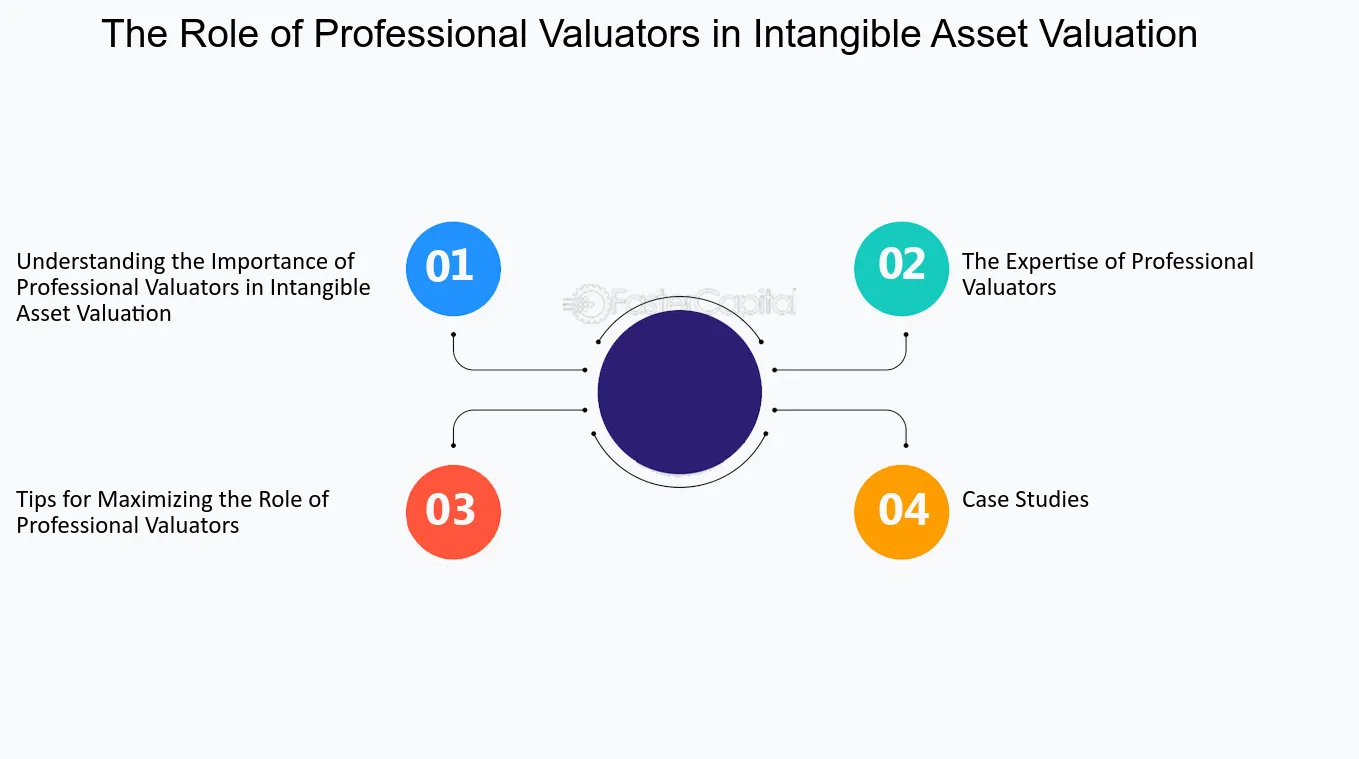
The Role of Professional Valuators in Intangible Asset Valuation - Unveiling Acquisition Adjustments: Untangling Intangible Asset Valuation
37. Importance of Intangible Asset Evaluation for Investors
Investors rely on accurate evaluations of intangible assets to make informed investment decisions. evaluating intangible assets helps investors assess a company's potential for growth, profitability, and future cash flows. It provides insights into a company's competitive advantage and market position. Effective evaluation of intangible assets allows investors to identify undervalued assets, make strategic investment choices, and maximize their returns.
Factors to Consider in Intangible Asset Evaluation for Investors:
1. Market demand and growth potential: Evaluating the market demand and growth potential of intangible assets helps investors determine their long-term value. For example, a patented technology with a large addressable market and strong growth prospects may have higher value compared to a trademark with limited market appeal.
2. Competitive landscape: Assessing the competitive landscape is crucial in understanding the potential of intangible assets. Investors need to consider factors such as the strength of competitors, barriers to entry, and the uniqueness of the asset. For instance, a strong brand reputation that distinguishes a company from its competitors can significantly impact its valuation.
3. Legal protection: Evaluating the legal protection of intangible assets is essential to gauge their sustainability. intellectual property rights, trademarks, and copyrights provide legal barriers that protect a company's intangible assets from unauthorized use. Investors need to consider the strength and enforceability of these protections when evaluating the assets' value.
4. Revenue generation potential: The revenue generation potential of intangible assets is a key factor in their evaluation. Investors analyze the historical and projected cash flows associated with the assets to determine their value. For example, a software product with a proven track record of generating significant recurring revenue can have a higher valuation.
5. Management effectiveness: The effectiveness of management in leveraging and monetizing intangible assets is an important consideration for investors. A strong management team with a clear strategy for utilizing and commercializing intangible assets can enhance their value. Investors need to evaluate the management's track record and capabilities in maximizing the assets' potential.
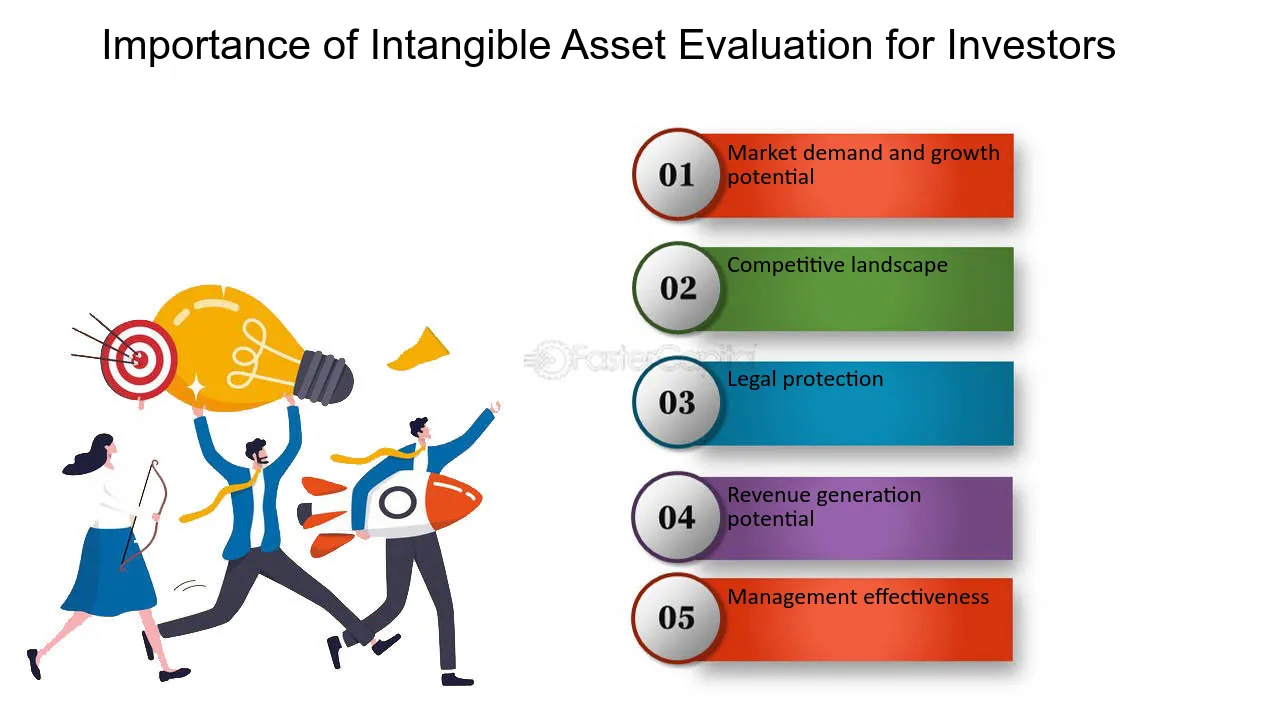
Importance of Intangible Asset Evaluation for Investors - Unveiling the Importance of Intangible Asset Evaluation
38. Factors That Influence Intangible Asset Evaluation
Several key factors influence the evaluation of intangible assets. By considering these factors, businesses and investors can gain a deeper understanding of the value and potential risks associated with their intangible assets.
Age and life cycle stage:
The age and life cycle stage of an intangible asset can significantly impact its value. Newer assets with strong growth potential and limited competition may have higher valuations. As assets mature, their value may stabilize or decline over time. It is essential to assess where an asset stands in its life cycle to determine its current and future value accurately.
Industry dynamics:
The industry in which an intangible asset operates can affect its value. Different industries have varying levels of competition, market demand, and growth potential. For example, an intangible asset in a high-growth industry with few competitors may have a higher valuation compared to an asset in a mature industry with intense competition.
Intellectual property protection:
The strength and effectiveness of intellectual property protection can influence the evaluation of intangible assets. Assets with robust legal protections, such as patents or copyrights, are more valuable as they provide exclusive rights and prevent unauthorized use. Weak or expired intellectual property protections may reduce the value of an asset.
Technology obsolescence:
Technological advancements can render certain intangible assets obsolete. Assets tied to outdated technologies may lose value over time. It is crucial to assess the potential for technological obsolescence when evaluating intangible assets, especially in industries with rapid technological change.
Market demand and customer behavior:
Market demand and customer behavior are critical factors in intangible asset evaluation. Assets that meet current and future market demand are more likely to have higher valuations. understanding customer preferences, trends, and buying behavior can help assess the market value of intangible assets.
39. The Impact of Intangible Asset Evaluation on Financial Reporting
Intangible asset evaluation has a significant impact on financial reporting. Accurate and reliable valuation of intangible assets is crucial for presenting a company's financial position, performance, and potential risks to stakeholders.
Balance sheet reporting:
Intangible assets are reported on the balance sheet, and their valuation affects the company's total asset value. Accurate valuation ensures that the balance sheet reflects the true worth of intangible assets and provides stakeholders with a clear picture of the company's asset base.
Impairment testing:
Intangible assets are subject to impairment testing to assess whether their value has been impaired due to factors such as changes in market conditions, technological advancements, or legal disputes. Proper evaluation of intangible assets helps determine whether impairment charges should be recorded and reflects their true value.
Amortization and depreciation:
Intangible assets with finite useful lives are subject to amortization or depreciation. Accurate valuation of these assets ensures that amortization or depreciation expenses are properly recorded, reflecting the asset's gradual consumption or loss of value over time.
Goodwill assessment:
Intangible asset evaluation is essential for assessing goodwill, which represents the excess of the purchase price over the fair value of net assets acquired in a business combination. Proper valuation of intangible assets acquired in a transaction helps determine the amount of goodwill and ensures compliance with accounting standards.
40. The Future of Intangible Asset Evaluation
As the global economy continues to evolve, the importance of intangible assets is expected to increase even further. Technological advancements, changing consumer behavior, and the rise of the digital economy will continue to shape the value and relevance of intangible assets.
Digital transformation:
The ongoing digital transformation will lead to the creation of new intangible assets and redefine traditional ones. Technology-related assets such as software, data, algorithms, and digital platforms will become increasingly valuable. Evaluating these digital assets will require new valuation methods and frameworks.
Data analytics:
With the proliferation of data, analytics-driven insights will become crucial in intangible asset evaluation. The ability to extract meaningful insights from large volumes of data will enhance the accuracy and reliability of valuation models. data-driven approaches will provide a more comprehensive understanding of the value and potential risks associated with intangible assets.
ESG considerations:
Environmental, social, and governance (ESG) factors are gaining prominence in investment decision-making. Evaluating intangible assets from an ESG perspective will become essential for investors seeking sustainable and responsible investments. Incorporating ESG considerations in asset valuation will provide a holistic view of a company's value and long-term prospects.